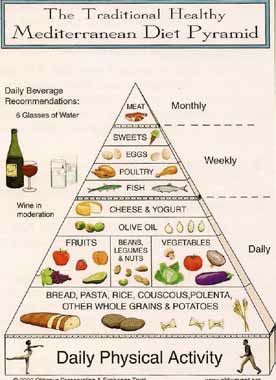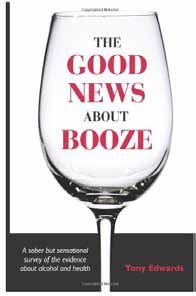PinotFile: 9.37 February 4, 2014
|
Roadhouse Winery: Pleasing Pinot Noir in HealdsburgThe name is intriguing, the labels are cool, the Pinots please the palate, and the tagline, “Two Guys, a Pool Table, Some Barrels and Love for Pinot Noir” was inviting, so I decided to investigate further. Principal owner and co-founder Eric Hall spent twenty years in the pre dot-com and dot-com world working in the San Francisco Bay area for Apple, Oracle, KPMG and others. Flush with Nasdaq gains after his last dot-com employer went public in 1999, he attempted to retire in Cazadero on the Sonoma Coast where he bought a former B&B. After the stock market went south in 2001, he sold the B&B and bought a small resort hotel in Guerneville in the Russian River Valley. He eventually teamed with his friends and family to create Roadhouse Winery in 2010, located in downtown Healdsburg. Eric spent a year working at Papapietro-Perry Winery in Healdsburg (Eric on the right with Bruce Perry is pictured below) and in late 2006, became a partner in an ill-fated venture formerly known as Russian River Vineyards in Forestville. He extricated himself from that business after a year or so, landing on his feet with the founding of Roadhouse Winery.
 Roadhouse winemaker Eric Hall produces just over 2,000 cases of Pinot Noir from Russian River Valley, Sonoma Coast and Yorkville Highlands grape sources, including notable vineyards like Weir, Nunes, Sangiacomo, Leras and Silver Pines. The tagline mentioned in the title of this article comes from the original start up when the first item they bought for the winery was a pool table which they still have. They also have essentially a full-on disco installed in their barrel room which thumps during their events. As a holdover from Eric’s tech days, he practices slot ranking but applies it to vineyards, rotating out the lower ranking 20% to 30% of vineyard sources each year, and trying new ones in the same areas, hoping to find ones that will perform better. This is why the color-coded labels do not mention the vineyard sources. Once a certain level of quality is displayed by a vineyard, and ongoing agreements on farming practices are secured, some of the wines and their colored labels will be vineyard-designated. The vineyard sources are top notch as you can see by the wines reviewed below which are the first releases from the 2012 vintage. Upcoming 2012 releases include Pinot Noir from Sangiacoma Roberts Road, Weir, and Tina Marie vineyards. The four wines reviewed here are all well-crafted, and along with their diversity of clonal mixes, they all show individuality. The winery’s website is www.roadhousewinery.com, and the Facebook page is www.facebook.com/ RoadHouseWinery.
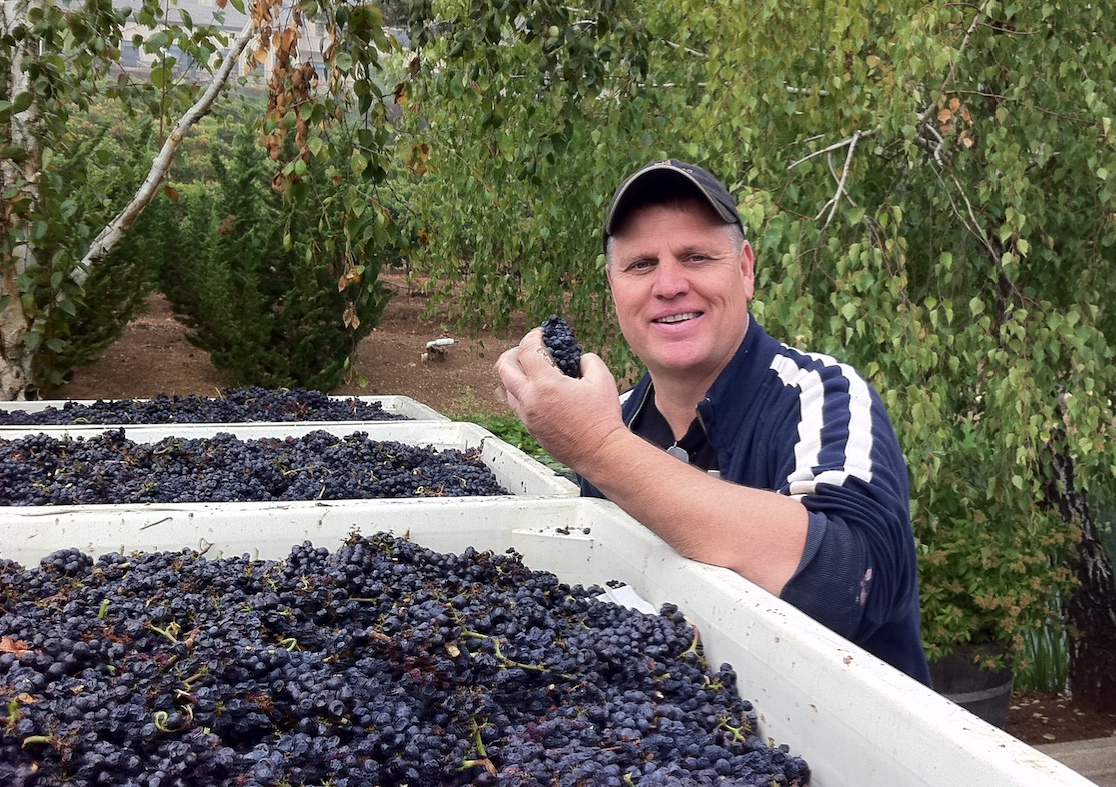
2012 Roadhouse Winery Yellow Label Russian River Valley Pinot Noir 14.6% alc., pH 3.74, TA 0.69, 325 cases, $46. Released fall 2013. Sourced from multiple River Road vineyards west of Highway 101 within two miles of the Russian River. Sandy-clay loam soils. Harvest Brix 25.5º. Clones 115, 2A. 100% de-stemmed, 5-day cold soak, inoculated fermentations, aged 12 months in 20% new, 60% 1 and 2-year-old, and 20% 3- year-old French tight grain or very tight grain French oak barrels. Unfined and unfiltered. · Moderately light reddish purple color with slight haze in the glass. Nicely perfumed with bright aromas of cherry, backing spice and red roses. Vibrant and juicy on the palate with a delicious core of Bing cherry fruit accented by cola, spice and pomegranate flavors. Very refreshing with well-integrated suede tannins and a pleasing and lingering finish. Score: 90
2012 Roadhouse Winery Orange-Red Label Russian River Valley Pinot Noir 14.7% alc., pH 3.70, TA 0.598, 375 cases, $49. Released fall 2013. From vineyards along Eastside Road in Windsor. Clones are Pommard, 115, 667, 777 and “828.” Harvest Brix 24º. 100% de-stemmed, 5-day cold soak, inoculated yeast fermentations, aged 12 months in 40% new, 60% 1 and 2-year-old medium toast, tight grain or very tight grain French oak barrels. Unfined and unfiltered. · Moderately light reddish-purple color with slight haze in the glass. Aromatically alive with scents of wild berries, blueberries, pomegranate and balsam. Mid to full-bodied core of dark red and blue fruits with a hint of black raspberry. More body than the Yellow Label with a touch more structural tannins and a more intensely fruity finish. Highly enjoyable. Score: 91
2012 Roadhouse Winery Dark Yellow Label Middle Reach Russian River Valley Pinot Noir 14.8% alc., pH 3.61, TA 0.67, 325 cases, $49. Release second quarter 2014. Wohler Road and Bacigalupi vineyards. harvest Brix 25.5º. Clones 2A, Pommard, Wente, “828,” and 667. 100% de-stemmed, 5-day cold soak, inoculated yeast fermentations, aged 12 months in 20% new, 60% 1 and 2-year-old, and 20% 3-year-old tight grain or very tight grain French oak barrels. Unfined and unfiltered. · Moderately light reddish-purple with slight haze in the glass. Shy aromas of red cherries and berries, underbrush, dried herbs and incense. The most savory wine of the four tasted here, also armed with a tasty essence of ripe cherry and red raspberry. The dry tannins are well-mannered, and the intense finish holds on. Score: 90
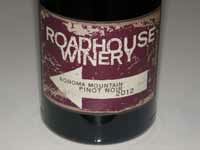 2012 Roadhouse Winery Dark Purple Label Sonoma Mountain Pinot Noir 14.8% alc., pH 3.65, TA 0.625, 275 cases, $49. Release first quarter 2014. Sourced from Silver Pine Vineyard located at the western edge of the Sonoma Mountain at 980 feet above sea level.Harvest Brix 26.5º. 100% de-stemmed, 5-day cold soak, inoculated fermentations, aged 12 months in 20% new, 60% 1 and 2- year-old, and 20% 3-year-old tight grain or very tight grain French oak barrels. Unfined and unfiltered. · Medium reddish-purple color and slight haze in the glass. This wine’s nose is the clear standout with effusive aromas of black cherry, blackberry, spice and earthy flora. The ripest and darkest-fruited wine of the four tasted today. This wine really stands out from the pack with mouth-filling flavors of black cherry pie, black raspberry jam and spice. Medium to full-bodied, and creamy in the texture, with a spectacular finish that explodes with fireworks in the mouth. The wine picks up allure over time in the glass. I have had some exceptional wines from this vineyard and this beauty follows suite. Score: 94
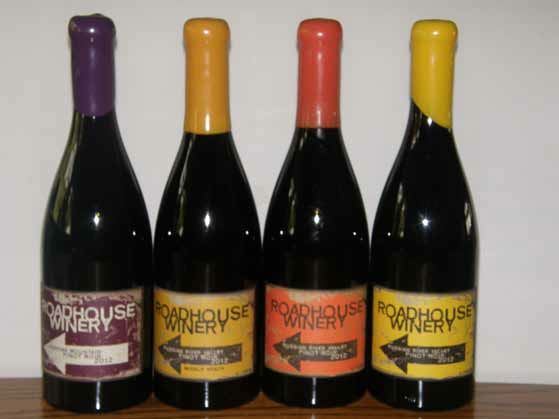
McIntyre Vineyards Celebrates 25th AnniversaryThe McIntyre Family Estate Vineyard consists of 37 acres of own-rooted Pinot Noir, known as the “heritage clone,” the oldest Pinot Noir planting in the Santa Lucia Highlands, along with 10 acres of 115, 777 and Swan Pinot Noir, and 13 acres of Chardonnay, clones 96 and 76. The McIntyre portfolio also includes Pinot Noir planted at Mission Ranch, clones 667 and 777. The McIntyre Family Estate Vineyard was originally planted by the McFarland family in 1973 and historically was used primarily for making sparkling wine. In 1987, the McIntyre family bought the 80-acre property near Gonzales and began to replant portions of the site. Steve McIntyre’s experience as winemaker for neighboring Hahn Estate’s Smith & Hook label led him to be a promoter of the region and he played a major role in the Santa Lucia Highlands gaining appellation status in 1991.
 Steve earned degrees in both viticulture and enology, graduating from California State University at Fresno with a Masters in Enology. His company, Monterey Pacific, farms hundreds of acres, has planted vineyards for Mondavi, Joseph Phelps and Bonny Doon, and as founding members of the Monterey Wine Company, has produced wines for Bonny Doon, Caymus, Hahn Estates and more. McIntyre’s vineyard plantings were among the first to be SIP (Sustainability in Practice) Certified in the Santa Lucia Highlands. Steve’s own label, McIntyre Vineyards, debuted with the 2005 vintage and has focused on the McIntyre Family Estate since 2006. The consulting winemaker is Byron Kosuge, a well-known vintner who is the son of a University of California at Davis professor. Byron was the winemaker for Saintsbury for 15 years before branching out on his own with B. Kosuge Wines, as well as making wine for Miura Vineyards, Foghorn and Kingston Family Vineyards in Chile. He is also a consulting winemaker for a number of Napa and Sonoma wineries. The McIntyre Vineyards Tasting Studio is located inside the lobby of the Hyatt Regency Hotel & Spa in Monterey and open daily. Visit the informative website at www.mcintyrevineyards.com. The wines from the 2012 vintage reviewed here are highly recommended. The 2012 vintage marks Steve’s 25th year farming the McIntyre Family Estate.
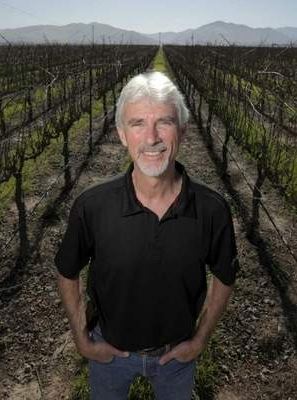
2012 McIntyre Vineyards Santa Lucia Highlands Pinot Noir 14.3% alc., pH 3.76, TA 0.58, 604 cases, $32. Released December 2013. A blend of two vineyards and three different clones: 943 and Swan from Escolle Vineyard and 777 from the McIntyre Estate Vineyard. Harvest Brix 25.0º. Aged 10 months in 33% new French oak barrels. · Moderately dark reddish purple color in the glass. Bright aromas of boysenberry, blackberry and spice. Mid to full-bodied core of ripe boysenberry fruit with hints of cassis and licorice. Nicely integrated oak and balanced tannins make for easy drinking now. Well-crafted and flavorful. Score: 90
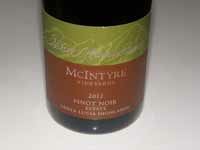 2012 McIntyre Vineyards Estate 25th Anniversary Edition Santa Lucia Highlands Pinot Noir 14.6% alc., pH 3.76, TA 0.60, 340 cases, $36. Released December 2013. Harvest Brix 25.0º. Dijon 115 and a “heritage” clone from a 40-year-old own-rooted planting of Pinot Noir. Indigenous yeast and malolactic fermentations. Aged in 33% new French oak barrels. · Moderately dark reddish-purple hue in the glass. The aromas have not arrived in this wine, but the delicious flavors are striking. An array of layered fruits meet the mid palate with ripe black raspberry, black currant, plum and dark chocolate notes. Full-bodied with firm but complimentary tannins. Impressive intensity with finishing power and persistence. An age worthy wine that needs time for the aromas to arrive and the tannins to integrate. More appealing the following day from a previously opened and re-corked bottle sporting inviting aromas of dark berries, black cherry and spice. Decant if you must drink now. A handsome and pedigreed example of Santa Lucia Highlands Pinot Noir. Score: 94
2012 McIntyre Vineyards Estate 25th Anniversary Edition Santa Lucia Highlands Chardonnay 14.4% alc., pH 3.76, TA 0.58, 792 cases, $28. Released December 2013. From a block of clone 76 planted in 2000. VSP trellis with cluster thinning. Harvest Brix 25.0º Brix. Whole cluster pressed, 20% whole cluster, fermented in new Siruge French oak barrels and aged in 33% new French oak barrels for 10 months. 100% MLF. · Moderate straw color in the glass. Lovely aromas of lemon, tropical fruits, floral display and a hint of buttered popcorn. A Caliesque style of Chardonnay with plenty of showy fruit flavor including lemon, pear and pineapple. Seductively creamy on the palate with bright underlying acidity and a silky finish. I couldn’t help returning to the glass to take another sip. A complete charmer at a very attractive price. Score: 94
Black Kite Cellars: Three Gems in 2011The name, Black Kite, does not refer to the type of aircraft attached to a tether, but rather the beautiful White Tailed Kite (formerly called the Black Shouldered Kite) that is endangered and native to Anderson Valley. The birds have penetrating red eyes that are prominently portrayed on the winery’s beautiful label. The Black Kite Cellars story begins with a bicycling trip in Burgundy, when Tom and Rebecca Birdsall thought they might be able to replicate the Burgundy terroir model in California. In 1995, their dream became a reality when their parents, Donald and Maureen Green, bought a remote 40-acre parcel just west of the town of Philo in the “deep end” of the Anderson Valley. The property consisted primarily of redwood forest and a 4-acre Gewürztraminer vineyard fronting the Navarro River. In 1999, the Greens replanted the exhausted vineyard to Pinot Noir and developed two additional blocks on the northern facing hill above the river, bringing the acreage to 12 acres. The Kite’s Rest Vineyard is divided into three distinct blocks or vineyards, distinguished by exposure, soil, row orientation and clonal selection. Redwood’s Edge is the highest elevation vineyard surrounded by redwoods, planted to Dijon 114 and 115 (photo below). Stony Terrace is the middle vineyard named after the soil makeup, positioned on a naturally benched hillside, and planted to Pommard clone. River Turn is the lower riverside vineyard named after the bend in the adjacent Navarro River and is also planted to Pommard clone.
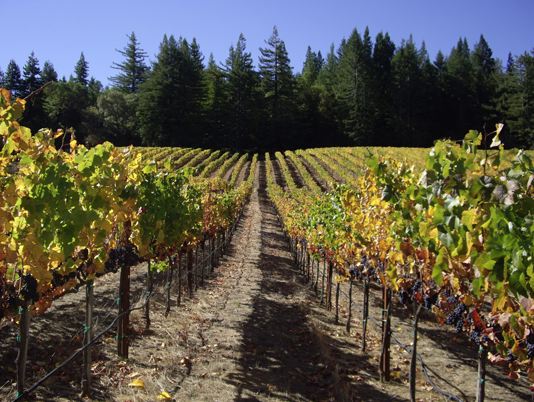 The first Black Kite Cellars Pinot Noir release came in 2003. Veteran winemaker Jeff Gaffner has been on board since 2004 and noted vineyardist Paul Ardzrooni has managed Kite’s Rest Vineyard since 2004. In most vintages, four wines are produced from the Kite’s Rest Vineyard: Kite’s Rest (a blend of the vineyard blocks), Redwood’s Edge, Stony Terrace, and River Turn. In 2011, grapes were harvested on October 19 and 20, and all three wines reviewed here were vinified in exactly the same manner to insure that the individual block signature characteristics would show through in the final wines. I found the 2011 Black Kite Cellars wines to be particularly appealing for their aromatic and flavor vibrancy, juiciness and electricity. Visit www.blackkitecellars.com for more information and to buy the wines.
2011 Black Kite Cellars Redwood’s Edge Anderson Valley Pinot Noir 13.8% alc., pH 3.60, TA 0.55, 149 cases, $55. Aged 11 months in 66% new French oak barrels. · Medium reddish purple color in the glass. Very expressive nose that expands over time in the glass. Aromas of black cherry, spice box and clove. Very stylish with mid weight flavors of black cherry and black raspberry with complimentary oak in the background. The overall impression is juiciness of fruit with a pleasing savory, earthy bent. The wine is the most brooding of the 2011 lineup and should benefit from more time in bottle to allow the firm tannins and oak to integrate. Better the following day from a previously opened and re-corked bottle. Could prove to be the best wine of the three reviewed here over time. Score: 91
2011 Black Kite Cellars Stony Terrace Anderson Valley Pinot Noir 14.2% alc., pH 3.60, TA 0.56, 203 cases, $55. Aged 11 months in 66% new French oak barrels. · Medium reddish purple color in the glass. The aromas are slow to arrive in the glass, becoming spectacular the following day from a previously opened and re-corked bottle. Very ripe, dark red and black fruits are featured, especially black raspberry, with hints of spice, dark chocolate and black currant. The tannins are modest, the acidity is bright and uplifting, and the special finish is vigorous with flavor and character. This wine will benefit from decanting or cellaring for a few years. Score: 93
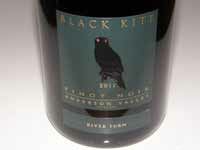 2011 Black Kite Cellars River Turn Anderson Valley Pinot Noir 14.3% alc., pH 3.60, TA 0.55, 148 cases, $55. Aged 11 months in 66% new French oak barrels. · Moderate reddish purple hue in the glass. Be sure you are sitting down when you taste this charmer. The aromas leap out of the glass with purpose, offering scents of black cherry, black raspberry, Asian 5-spice and a hint of oak. The most sappy and forward of the three 2011 Pinots tasted here. Flat-out delicious with layers of flavor including black cherry liquor, black raspberry jam, and Hoison sauce. The fine-grain tannins are svelte, the balancing acidity is spot on, and the finish is filled with sweet-scented and saucy fruit. The finish is even more intense and persistence the following day from a previously opened and re-corked bottle. Log on to deliciouspinot.com for a good time. Score: 94
Sips of Recently Tasted Wines
2006 JCB by Jean-Charles Boisset No. 65 Burgundy France Sparkling Wine 12.0% alc., $60. From a vineyard in Savigny-lès-Beaune. Aged in 100% stainless steel.. A Blanc de Noirs Brut Crémant de Bourgogne. · Pale apricot color in the glass. Aromas of pineapple, lemon and apple core. The flavors echo the nose with added nuances of lees, nectarine and kumquat. A dry, pleasing drink with a strong bead. Score: 87
NV JCB by Jean-Charles Boisset No. 69 Brut Rosé Burgundy France Sparkling Wine 12.0%, $60. A Crèmant de Bourgogne. The number signifies the birth year of Jean-Charles Boisset. Based exclusively on Pinot Noir. · Delicate coral pink color in the glass. The nose offers a perfume of cherry skin and toast. Flavors of cranberry, cherry, orange peel and tangerine with a tart, citrus-driven finish. Score: 86
2012 La Crema Monterey Pinot Noir 13.5% alc., pH 3.74, TA 0.54, >50,000 cases, $23. Aged 6 months 26% new, 96% French oak barrels. Racked once out of barrel before final blending. · Medium reddish purple hue in the glass. A diverse array of aromas are offered including red cherry and strawberry, plum, root beer and sandalwood. Easy to drink with modest weight flavors of red and black fruits accented with spice and oakdriven anise. Very elegant and supple, with well-integrated tannins and acidity. Widely available and a solid go-to wine for dinner. Score: 88
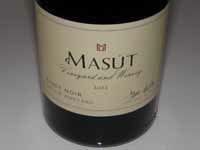 2012 Masút Estate Vineyard Mendocino County Pinot Noir 13.9% alc., 2,450 cases, $40. From brothers Jake and Ben Fetzer. 22.6-acre vineyard planted in 1997 at the headwaters of the Russian River Valley. Dijon clones 115 (73%), 777 (18%) and 113 (9%). 100% de-stemmed, 14-18 day fermentation, aged sur lie for 10 months in 33% new French oak barrels. · Medium reddish purple hue in the glass. Highly aromatic with black cherry and black plum scents accented by oak-driven toast and spice. Very smooth and seductive on the palate, with a middleweight core of vigorous black cherry, black raspberry coulis and cola flavors singing in cadence with thick oak notes. The fruit is beautifully ripened and rich on the mid palate, finishing with a generous presence. Tasted the following day from a previously opened and re-corked bottle, the wine still had a significant oak overlay. I would cellar this wine for a year or two to integrate the oak. Score: 90
**An updated wine map of Mendocino County showing the smaller sub-AVAs and the location of Masút is reproduced below.
2011 Patz & Hall Chenoweth Ranch Russian River Valley Pinot Noir 14.8% alc., 379 cases, $58. Wild and cultured yeast fermentations. 15% whole clusters. Aged in 65% new French oak barrels. Bottled without fining or filtration.From a 7-acre vineyard in Green Valley planted and farmed by acclaimed viticulturist Charlie Chenoweth. The site, which was originally an apple orchard, is farmed almost exclusively for Patz & Hall. Dijon clones planted in Goldridge soils. · Moderately dark reddish purple color. The oak-dominated nose also features aromas of black plum, black cherry, spice, peat and cigar box. Medium to full-bodied flavors of oakkissed red and purple fruits leave a lasting impression on the finish which exhibits an earthy flora tone. Very smooth in the mouth with balanced tannins. Significantly better the following day from a previously opened and re-corked bottle showing better oak integration and more vivid aromas and flavors. Score: 91
2011 Patz & Hall Burnside Vineyard Russian River Valley Pinot Noir 13.6% alc., 220 cases, $70. From a vineyard planted to clone 115 in Goldridge soil by the Martinelli family on a site that was a former hillside apple orchard. Burnside was picked at the last minute before the rains, and at 13.6%, is one of the lowest alcohol Pinot Noirs Patz & Hall has ever produced. Wild and cultured yeast fermentations, 15% whole clusters, aged in 50% new French oak barrels. Bottled without fining or filtration. · Dark reddish purple color in the glass. The nose is entirely oak-driven initially with no fruit evident. Full-bodied flavors of oak-kissed black cherry and blackberry, with a hint of licorice-laced cola. Somewhat of a brut of a wine that currently lacks personality. The fruit that does peek out seems quite pretty and there is some finishing persistence. Tasted the following day from a previously opened and re-corked bottle, the delicate fruit was still overwhelmed by oak. Time will tell. Score: 88
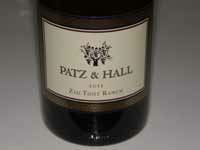 2011 Patz & Hall Zio Tony Ranch Russian River Valley Chardonnay 14.2% alc., 324 cases, $60. This vineyard was planted by the Martinelli family in 1990 on Frei Road in Green Valley. Patz & Hall has made wine from this vineyard since 2003. 100% Dijon clone 76. Whole cluster pressed, indigenous yeast fermentation, aged sur lie with weekly stirring, 100% MLF in barrel, aged in 65% new French oak barrels. Bottled without filtration. · Moderate golden yellow color with a slight haze in the glass. Lovely perfume of lemon curd, pineapple, golden apple and hazelnuts. Medium bodied and full-flavored featuring tastes of green apple and citrus, with a complimentary accent of oak in the background. Vibrant and energetic, with a spark of citrus-driven acidity on the refreshing finish. Score: 91
2012 POE Hudson Vineyard Carneros Pinot Noir 13.6% alc., $45. · Medium reddish purple color in the glass. Very shy aromas of dark berries, oak and a little barnyard. Middleweight flavors of dark berries, grilled mushrooms, spice and earth with some oak showing up on the finish. Very supple tannins. Quite typical of many Carneros Pinot Noirs. Rather brooding and mysterious now, improving some over time in the glass, but needing more time in bottle. When tasted the following day from a previously opened and re-corked bottle, there was still little fruit on the very shy nose and the wine remained rather closed. I sense potential here but patience is required. Score: 88
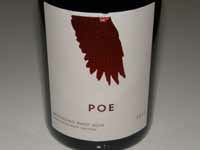 2012 POE Manchester Ridge Vineyard Mendocino Pinot Noir 13.8% alc., $48. 15% whole cluster. · Moderately dark reddish purple color in the glass. Very exotic and appealing nose with expressive aromas of dark berry preserves, spice, potpourri and redwood forest. Highly pleasurable on the palate with waves of perfectly ripened, juicy cherry, berry and black plum fruits. Soft in the mouth, with suede tannins and fresh acidity. The wine finishes with a spicy flourish, although not dramatically long. Spectacular the following day from a previous opened and re-corked bottle with highbrow aromatics and flavor to spare. Score: 93
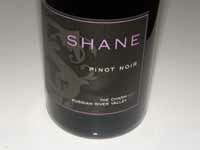 2011 SHANE The Charm Russian River Valley Pinot Noir 14.1% alc., pH 3.56, TA 0.63, 250 cases, $45. Third issue of this wine sourced from vineyards managed by Ulises Valdez. Winemaker Shane Finley was former assistant winemaker at Kosta Browne. Clones are 777, Pommard, Calera and Swan. Aged 14 months in 30% new French oak barrels. · Moderately dark reddish purple color in the glass. Quite aromatic with bright aromas of black cherry, raspberry and Moroccan spices. Mid weight flavors of black cherry, pomegranate and spice with a riff of oak in the background. Soft and seamless, with balanced tannins. An upfront wine of immediate appeal. Impressive in this challenging vintage. Score: 91
2010 SOHO White Marlborough New Zealand Pinot Noir 13.7% alc., $18, screwcap. A newer winery founded in 2009 by Rachael Carter whose family has been involved in the New Zealand wine business for over 40 years. The winery has won multiple awards. Younger sibling of Black Label. Winemaker Dave Clouston. Imported by Nedrac Inc., Palm Desert, CA. · Moderate reddish purple color in the glass. Aromas of black cherry, toasted oak and campfire. Medium weight flavors of black cherry with a prominent oak sheen. Supple tannins, bright acidity and easy to drink. Score: 84
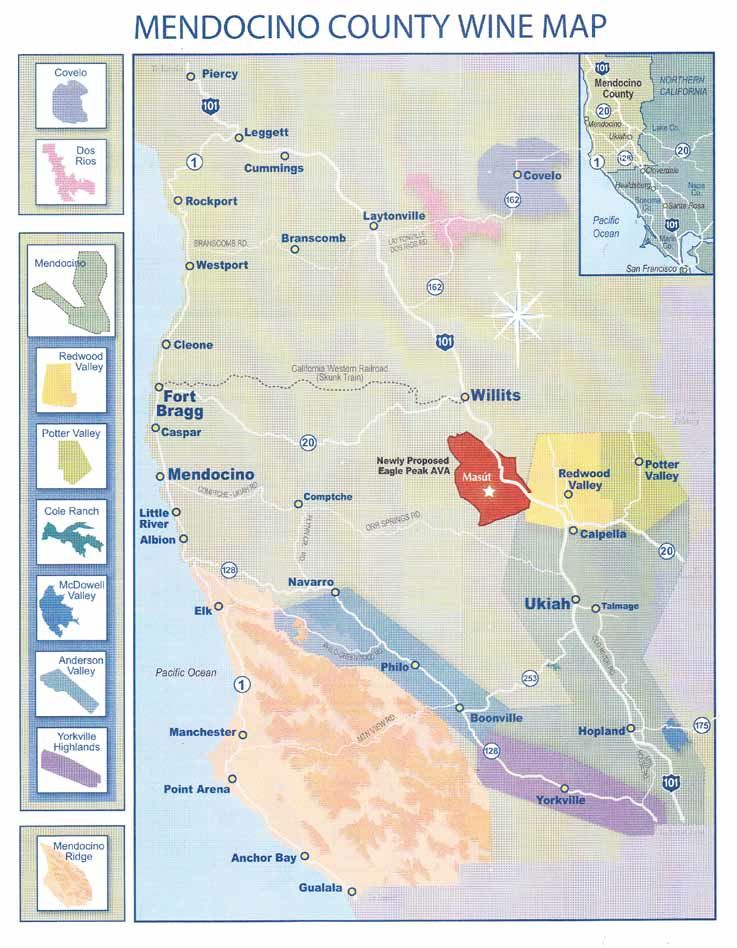
Wine as Part of a Healthy Lifestyle: Introduction
Andrew Waterhouse, Professor of Viticulture & Enology, University of California at Davis
Readers will find this review helpful in keeping them informed about important scientific publications and policy statements. However, it cannot be emphasized enough that they should follow the lifestyle, diet and drinking advice of their doctors. A number of issues related to alcoholic drinks and health were prominent in the news and scientific press in 2013. The escalation of drinking in women received the most publicity along with continued controversial studies and recommendations regarding drinking during pregnancy and the relationship of drinking to breast cancer. The ongoing debate over the relative advantages of drinking wine versus beer received notice as did the tendency of the public to incorrectly understand the idea of a standard drink, frequently believing a standard drink is of greater volume than it is. There were a number of new alcohol related laws and taxes proposed both in the United States and abroad, and wine labeling issues continued to occupy the public’s interest. Some alarming studies on binge drinking in young people and the resulting adverse health consequences, should bring all parents and advisers to attention. Studies of polyphenols, particularly resrveratrol, continue to show health benefits, perhaps a role in increased longevity, and some value in preventing and or treating cancer, although the results continue to require a cautious interpretation. Finally, there were some major research studies reported on the relationship of moderate alcohol consumption and health and lifestyle. No new policy recommendations were issued by the United States government in 2013. The most recent revised National Institutes of Health 2010 Dietary Guidelines for Americans (www.health.gov/dietaryguidelines/) include information on the benefits of moderate drinking, but they do not advise abstainers to begin drinking for health reasons. The Dietary Guidelines are being reviewed in 2014 and the 8th edition of The Dietary Guidelines will be published in the fall of 2015. In the following pages, I will summarize peer-reviewed, scientific studies published in 2013 that contribute to our understanding of the roles that alcohol, and in particular wine, play in our health. Papers presented at conferences are also included. This year I have chosen to be more concise since I realize most readers of this publication are not interested in an extensive discussion and critique of each scientific article. For those wishing to seek out the articles in their entirety, visit PubMed which comprises more than 21 million citations for the biomedical literature from MEDLINE, life science journals and online books: www.pubmed.gov. In the capsular summaries of research, I have referred to “The Forum” a number of times for consensus opinion on the validity of some study’s conclusions. The Forum is the International Scientific Forum on Alcohol Research, a joint undertaking of the Institute on Lifestyle & Health of Boston University School of Medicine and Alcohol in Moderation (AIM) of the United Kingdom. The Forum includes a voluntary group of epidemiologists, statisticians, basic scientists, physicians, psychologists and specialists in social matters, psychology and public health. For further general and detailed information about alcoholic drinks and health, consult the following websites:
US Centers for Disease Control and Prevention (CDC): www.cdc.gov/alcohol/ UK National Health Service: www.nhs.uk Drinkaware: www.drinkaware.co.uk Alcohol, Other Drugs, & Health: Current Evidence: www.bu.edu/aodhealth/ AIM Alcohol in Moderation: www.aim-digest.com International Scientific Forum on Alcohol Research: www.bu.edu/alcohol-forum/ Wine Doctors: www.winedoctors.com Health and Wine: www.healthandwine.blogspot.com/ Society of Medical Friends of Wine: www.medicalfriendsofwine.org/ Wine in Moderation: www.wineinmoderation.eu The French Paradox: www.french-paradox.net As a prelude to considering any study on the relationship between alcoholic drinks and health, it is important to understand the definition of “moderate drinking” since it is frequently referenced in research articles and is the level of drinking associated with health benefits in men and women. A few key definitions must be clearly understood. In the United States, a standard drink or unit contains 17.7 ml of ethanol (about 14 grams of pure alcohol) which is equivalent to 12 ounces of beer (about 5% alcohol), 5 ounces of table wine (about 12% alcohol) and a shot or 1.5 ounces of 80 proof distilled spirits (about 40% alcohol). A full bottle of wine (750 ml) contains about 5 to 7 standard drinks depending on the wine’s alcohol percentage. To determine the number of standard drinks in a bottle of wine, multiple 750 ml by the alcohol percentage and divide by 17.7. The 2010 Dietary Guidelines for Americans (DGA) state that if alcohol is consumed, it should be consumed in moderation which is defined as no more than 1 standard drink per day for women and no more than 2 standard drinks per day for men. This definition refers to the amount consumed on any single day and is not intended to be an average over several days. The National Institute of Alcohol Abuse and Alcoholism states that men should not exceed 4 drinks per day or a total of 14 per week and women should not exceed 3 drinks a day or a total of 7 per week. The American Heart Association recommends that men not exceed 2 units a day and women should not exceed 1 unit a day. When drinking wine, one must take into account the alcohol percentage, scaling back the volume of drinking when imbibing a wine with a higher alcohol by volume or reaching for a lower alcohol wine to insure that you stay within the confines of drinking moderately. Remember also, that wines that are under 14.0% can be mislabeled by up to 1.5%, and wines that exceed 14.0% in alcohol can vary by 1% (a wine that says 14.1% on the label can actually contain 15.1% alcohol by volume). Drinkers commonly underestimate the amount of alcohol they imbibe, thinking a standard drink is of greater volume that it is. This is termed the “over-sizing effect” and leads to a false sense of drinking within the confines of moderation. Over-imbibing can be unintentional because of the various shapes of wine glasses, with wide glasses typically receiving inordinately larger pours. A study of wine-drinking subjects published in 2013 in Substance Use & Misuse from Iowa State University found (1) the average pour into a wide glass was 11.9 percent higher than into a standard glass; (2) 12.2 percent more wine was poured when a glass was held versus a glass placed on a table; (3) white wine pours were 9.2 percent more generous than red. A Riedel Vinum Burgundy glass that is half-filled, holds a surprising 12 ounces. The photo below shows a Vinuum XL glass containing about 6 ounces, or close to one standard drink.
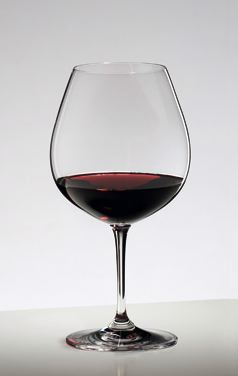 Measuring wine glasses are available for health conscious wine drinkers who want to be able to measure their wine consumption. Discreet bubbles on the glass mark 4, 6, and 8 ounce portions on lead-free crystal from a Riedel factory in Germany. Both red and white wine moderation glasses are available. The glasses are endorsed by California cardiologist Steven R. Gundy, M.D.. To buy, visit www.mr-picky.com/moderation-wineglasses/. There are other versions of measuring wine glasses including the “Caloric Cuvee,” which has marks to note calorie intake of various pours, but I am put off by the top mark on the glass which says, “Who cares?” A Health Survey for England conducted by the University College London and published in the European Journal of Public Health found that as many as three quarters of the people in the UK underestimate the amount they drink by up to 40 percent. Although four in five considered themselves a “moderate drinker,” they admitted to frequently exceeding the safe guidelines, but had no intention of scaling back. The study was based on the difference between self-reported alcohol consumption and alcohol sales. After the research was published, visits to Drinkaware’s website at www.drinkaware.co.uk/ surged to a five-year high and those who searched on the website for “how many units in a bottle of wine” rose 467%. Data taken from the National Health and Nutrition Examination Survey, 2009-2010, were analyzed and reported in the Journal of the Academy of Nutrition and Dietetics published online. On any given day, 36% of men and 21% of women consumed alcohol in the United States. 18 percent of men and 11 percent of women drink more alcohol than federal guidelines recommend and 8 percent of men and 3 percent of women are “heavy drinkers.” The percentages who drank more than the the government’s recommended limits were highest among men age 31 to 50 years and women age 51 to 70 years. The Survey concluded that the great majority of Americans stay within daily alcohol guidelines. A study released in 2013 from the Centers for Disease Control and Prevention found that excessive alcohol consumption costs the United States $223.5 billion a year. The study came from data in 2006. The costs were largely due to losses in workplace productivity, criminal justice expenses, motor vehicle crash costs, property damage, and higher healthcare demands. Binge drinking (five or more drinks on an occasion for men or four or more drinks on an occasion for women) was responsible for more than 70% of excessive alcohol use related costs. On May 28, 2013, the Alcohol, Tobacco, Tax and Trade Bureau (TTB) issued a voluntary nutrient content statement in the labeling and advertising of wines, distilled spirits and malt beverages. The Serving Facts statement includes serving size, the number of servings per container, and the number of calories and the number of grams of carbohydrates, protein, and fat per serving. The serving size for wine above 16% alcohol by volume is 2.5 fl oz and for wine between 7% and 16% alcohol by volume, 5 fl oz. An example of a proposed nutritional label for a 750 ml bottle of wine:
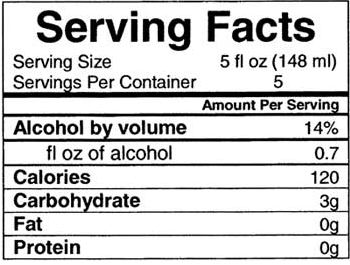 Wine writer Katie Kelly Bell wrote an article in Forbes, September 3, 2013, titled, “Are You Drinking Too Much? The Myth of Moderation.” I love her quote, “Today, it’s easier to solve a trigonometry problem in your head than to get a straight answer about how much we should be drinking each day.” I say, don’t obsess with the question of moderation. For maximum health benefits, have a modest glass or two of wine several days of the week with dinner, and avoid splurges. One approach that encourages moderation are lower alcohol or “lifestyle” wines which continue to be in the international news but have not taken off in this country. New Zealand is looking to be the world’s leading producer of lower calorie and lower alcohol wines. The producers there are trying to distinguish themselves by offering premium wines naturally produced using sustainable viticulture and native yeasts. Some of New Zealand’s largest wineries have signed up for the program including Giesen Wines, Mud House Wine Group, Pernod Ricard NZ, Spy Valley Wines, Villa Maria Estate, and Yealands Estate Wines.
Wine as Part of a Healthy Lifestyle: A Review of 2013 Conferences
The International WineHealth13 conference was held in Sydney, Australia, July 18-20, 2013. This was a gathering of scientific researchers in the field of alcohol and health, and included members of the Australia Wine Research Institute and the Boston University School of Medicine. Their conclusions, based on years of studies and papers presented at the conference, could be summarized by ten health benefits of moderate drinking (Daily Telegraph, July 19, 2013):
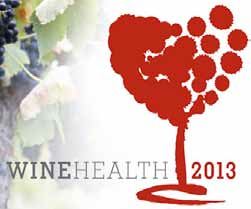
(1) Lower rates of heart disease, particularly evident with moderate red wine consumption since both alcohol
and polyphenols are strong risk reducers.
The Australian Research Institute outlined the benefits of moderate drinking after the conference and noted that drinking one to two standard glasses of wine or other alcohol regularly provides health benefits for most healthy people. The Institute pointed out the findings are not applicable to young people. The key is moderate intake over a regular period, but not necessarily every day. Heavy or binge drinking is clearly associated with adverse health consequences. The Australia National Health and Medical Research Council recommends that for healthy men and women, drinking no more than two standard drinks on any day reduces the lifetime risk of harm from alcohol related disease or injury. Public health experts in Australia complained that the conference presented one-sided evidence on wine’s health benefits and that the health benefits of wine have probably been overestimated. Brian Vandenberg, senior policy adviser at Cancer Council Victoria, told www.theage.com.au, “Alcohol leads to weight gain and it’s linked to many cancers, so a conference about the health benefits of wine is about as credible as a conference about the health benefits of smoking or saturated fat.” WineVision conference The inaugural WineVision conference was held in November 2013 in London. Dr. Erik Skovenborg, a member of the International Scientific Forum on Alcohol Research, told attendees that he found no evidence to support the notion that one alcohol free day per week had health benefits, providing one drinks in moderation. He emphasized that any health benefits from drinking were only applicable to moderate drinkers. Hong Kong International Wine & Spirits Fair Dr. Justin Cohen, research fellow at the Ehrenberg-Bass Institute for Marketing Science, surveyed 913 upper and middle-class urban Chinese aged 18 to 50. He found that Chinese consumers drink wine primarily for its health benefits and not for its taste or luxury status. The second most important motivation for drinking wine was helping consumers to relax. Taste was the fourth most important reason for drinking wine. Red wine is specifically bought because of its perceived health benefits and its favored taste. Reported in www.thedrinksbusiness, November 11, 2013
Wine as Part of a Healthy Lifestyle: A Review of the 2013 Scientific Literature
A United States study looked at the relationships between wine preference and health determinants in 12,958 adults who participated in the National Longitudinal Study of Adolescent Health. Wine drinkers had more formal education, better dietary and exercise habits, and a better overall health status. More of the wine drinkers were light to moderate drinkers compared to beer or liquor drinkers, and wine drinkers were less likely to be smokers. The findings suggest that wine preference in young adults is related to educational, health and lifestyle factors and may at least partially explain the association between light to moderate wine consumption and morbidity and mortality risk in later adult life. Published in Teatro Naturale. The Drinks Business (www.thedrinksbusiness.com) reported on a number of centenarians who credit wine for their long life. Alice Mospak, who turned 104 in early 2013 and lives in Jersey City, attributes her long life to red wine and chocolate. Helen Kinsey, of Tattershall, Lincolnshire, celebrated her 100th birthday and agreed with Mospack except her preference was for a glass of white wine rather than red wine. Wine writer Dan Berger pointed out the ages of death of prominent wine business figures: winemaker Andre Techelistcheff, 92; winemaker Louis Foppiano, 101; wine author and bon vivant Andre Simon, 92; wine lover, collector, and Bordeaux chateau manager Harry Waugh, 97; winery owner Ernest Gallo, 97; vineyardist Julio Gallo, 83 (died while driving a 4-wheel drive vehicle in his vineyards); wine researcher Dr. Ralph Kunkee, 84; winery owner Robert Mondavi, 94; winemaker Lee Stewart, 89; wine writer Robert Lawrence Balzer, 99; wine author Leon Adams, 90; and wine professor and researcher Maynard Amerine, 87. Winemaker John Parducci, 96, and winemaker Charlie Barra, 86, are still with us. A major study by 36 authors was published in 2013 on moderate alcohol consumption and health in Nutrition, Metabolism, & Cardiovascular Disease, and was reviewed by the International Scientific Forum on Alcohol Research (The Forum). There is a tremendous amount of research data available on the relation of alcohol consumption to health and disease. This paper by a large number of Italian scientists tried to reach a consensus on the relation of moderate alcohol consumption to health. The Forum believed that the consensus had great merit. “The overall impression of Forum members is that light-to-moderate drinking in middle-aged and older adults who have no contraindications to alcohol (e.g., prior abuse, uncontrolled epilepsy, and a few other medical conditions) is associated almost exclusively with beneficial health benefits. Such healthy outcomes are generally not seen among the young, due mainly to the rarity of the occurrence of the ‘diseases of aging’ among the young. It is also related to their frequent abuse of alcohol, from binge drinking and purposely drinking just for intoxication.” Members of the forum agree with the authors of this report that changes in one’s drinking habits should be discussed with the person’s physician, as age, sex, underlying medical conditions, religion, and other factors should be taken into account. A study published in the Journal of Epidemiology Community Health, reported divergent effects of regular moderate and binge drinking over more than 20 years among a large cohort of young to middle-aged Norwegian subjects. The study was unusual in that most of the subjects consumed alcohol once a week or less frequently, but consumed large amounts of alcohol on each drinking day. Only 11% of men and 3% of women consumed alcohol more than once a week. 76% of the men reported binge drinking at least once during the preceding year and 36% of the women reported binge drinking a few times or more frequently in the last year. Men and women who consumed alcohol up to twice a month had about 20% lower mortality than abstainers. All groups reporting binge drinking had higher mortality than non-binge drinkers. Cardiovascular and ischemic heart disease mortality was lower among drinkers but higher among those who reported binge drinking. The Forum said, “The key finding of this study is that there are divergent effects on mortality of the frequency of drinking and the amount of alcohol consumed per occasion. The results support other studies of more moderately drinking populations, namely, that more frequent drinking, but smaller amounts per occasion, is the pattern of alcohol consumption associated with the lowest risk of mortality.” Americans have misconceived notions about the risks of heavy drinking according to a 2013 national survey of adults released in April by Screening for Mental Health, Inc., and reported at www.prnewswire.com. The survey found that half of all men and one-third of women had at least one at-risk drinking episode (four or more drinks per day for men and three or more for women) in the last year. 20 percent of Americans believe that at risk drinking is not a problem unless it negatively impacts their personal relationships or work performance. 20 percent believed that drinking heavily is a phase that many young people go through, but it won’t hurt their health in the long run. This is not consistent with the findings of the National Institute on Alcohol Abuse and Alcoholism which found that young people who started drinking before age 15 were 50% more likely to become alcohol dependent as adults. A study by the Center for Addiction and Mental Health (CAMH) reported at www.huffingtonpost.ca and published in Addiction, found that alcohol is now the third leading cause of global disease and injury, despite most adults worldwide abstain from drinking. Drinkers in Europe and parts of Sub-Saharan Africa are the world’s heaviest consumers of alcohol. North Americans in general and Canadians in particular drink more than 50 percent above the global average and demonstrate a more detrimental drinking pattern that most EU countries. The most unhealthy drinkers were in the age bracket of 15 to 29-year-old. People in this age group worldwide still suffer the most deaths from alcohol. The journal Alcoholism: Clinical & Experimental Research, reported the results of the Hunt Study. Data collected from 19,977 married couples in Norway found that spouses who drank the same amount of alcohol were less likely to divorce than spouses where one partner was a heavy drinker and the other was not (particularly if the woman was the heavy drinker). Divorce was more common among couples with high rates of alcohol consumption (17.2%). Couples in the study who were both light drinkers reported only a 5.8% divorce rate. A preliminary study by Spanish and Mexican researchers reported in www.beveragedaily.com, January 20, 2014, found that even relatively light weekend drinking may damage young, healthy student DNA. Those who drank had twice as much oxidative damage as well as evidence of significantly increased numbers of DNA damaged cells compared with the group that did not consume alcohol. A University of Colorado retrospective study of more than 41,000 people from across the United States surveyed for their drinking habits in 1988 and followed until 2006 published in the Journal of Population Research and Policy Review, found that abstainers have a higher mortality risk than light drinkers (on average, less than one drink a day). Considerable scientific evidence has shown that light to moderate alcohol consumption, compared to abstaining and heavy drinking, can help prevent a range of diseases. However, the Colorado study found that nondrinkers have many reasons for abstaining and this affects their individual mortality risk so that some people such as those who choose not to drink because of religious or moral reasons are at the same risk as light drinkers. Former drinkers had the highest mortality risk of all nondrinkers (38% higher mortality risk over the follow-up period). The authors of the study suggested that their findings indicate that not all nondrinkers have a higher mortality than light drinkers. As far as drinkers, those who drank between one and two drinks per day, on average, had a 9 percent higher mortality rate than light drinkers, those that drank between two and three drinks per day had a 49 percent higher mortality and drinkers who consumed more than three drinks per day had a 58 percent higher mortality risk over the follow-up period compared with light drinkers. In concluding, the authors of the study noted that there are probably other factors that lower mortality for light drinkers such as higher socioeconomic characteristics, and “the idea that drinking could be somewhat beneficial seems like it’s overstated.” The “J-shaped curve” (below) that describes the association between alcohol consumption and mortality has been confirmed by many epidemiological studies over the past decades. Abstinence is an adverse health risk, light-to-moderate drinking lengthens life with the lowest mortality level for men and women at one to two drinks per day, and excessive drinking (more than three drinks per day) is the most dangerous to health and life. This curve holds true also for cardiovascular disease, stroke, some cancers, and cognitive dysfunction. The J-shaped curve is widely accepted whenever health and alcohol consumption is debated. A large study reported in Alcohol Clin Exp Res looked at the J-shaped curve and the relationship of “heavy” (more than 5 drinks on occasion) and “non-heavy” (less than 5 drinks per occasion) alcohol consumption to the risk of all-cause mortality. There was a linear increase of mortality for subjects consuming heavy amounts of alcohol, with the risk increasing as drinking at this level was more frequent. For non-heavy drinkers, there was a J-shaped relation with mortality. The point at which the non-heavy drinker’s risk of mortality exceeded that of abstainers was between 4 and 5 drinking occasions per week. Previous epidemiological studies defined moderate or non-heavy at lower levels of alcohol intake and looked at drinks per day or drinks per week, yet the results of this study of drinking patterns were similar and confirmed the J-shaped curve.
 A large study from Australia published in Alcohol Clinical Experimental Research, that included a high percentage of current or former alcohol abusers, had several key findings: moderate alcohol intake had favorable effects on HDL cholesterol and insulin levels, and for most other factors (liver enzymes, triglycerides, blood glucose, and the inflammatory marker CRP) a J-shaped relation or lower values with light drinking and higher levels with larger amounts of alcohol. The Forum felt that this study provided strong support for the results of most prospective epidemiological studies that show lower rates of cardiovascular and other diseases among light-to-moderate drinkers than among abstainers or heavy drinkers. A consensus statement published in Nutrition, Metabolism & Cardiovascular Disease by 36 prominent nutrition scientists in Italy came as a surprise as some European countries have openly opposed alcohol even in moderation. The statement: “In healthy adults and in the elderly, spontaneous consumption of alcoholic beverages within 30 grams of alcohol daily (up to two drinks) for men and 15 grams for women (1 drink) is to be considered acceptable and does not deserve intervention by the primary care physician.”
 Women are drinking more often and drinking too much. This was brought to light in Gabrielle Glaser’s book published in 2013, Her Best Kept Secret: Why Women Drink and How They Can Regain Control. A Q&A published at www.time.com in July explained what she had learned in researching her book. Glaser said that women are drinking more than their mothers did and 11% report regular bouts of binge drinking. A 2010 Gallup poll showed that nearly two-thirds of all American women drank regularly which was a higher percentage than in any other time in twenty-five years. The rate of females being hospitalized from alcohol is increasing five times that of men. She noted that for women, drinking results from stress, depression and anxiety, and drinking allows them to self-medicate their woes, with alcohol functioning as a release valve to allow them to calm down, and “feel sexier and warmer.” Literally, the demands of marriage, career and motherhood are driving women to drink. The more educated and well off a woman is, the more likely she is to drink. White women drink more than women of other racial backgrounds. Another book published in 2013, Drink: The Intimate Relationship Between Women and Alcohol by Ann Dowsett Johnson, combines in-depth research with her own personal story of recovery. She points out that women are exposed to a wine industry set up to sell Skinnygirl cocktails, book clubs that are really wine clubs, and websites that encourage drinking (for example, Moms Who Need Wine). Johnson describes a syndrome I was unaware of called “drunkorexia,” which is the choosing to limit eating to consume greater quantities of alcohol. Table wine brands that target women are big sellers with Skinnygirl from California the top new seller by far at $4,755,489 in 2012 according to Wines & Vines. Other brands in the top twenty include Fancy Pants, Thorny Rose, Flirt, Butterfly Kiss and Flame Lily. A third book published in 2013, The Sober Revolution: Calling Time on Wine o’clock by Sarah Turner and Lucy Rocca, looks at women and their relationships with alcohol and offers insights for women to regain control of their drinking. A blog, “Drinking Diaries,” at www.drinkingdiaries.com, is an extension of a fourth book, Drinking Diaries: Women Serve Their Stories Straight Up by Caren Osten Gerszberg and Leah Odze Epstein in which women share their drinking stories honestly and openly in this favorably reviewed book. According to the Centers for Disease Control and Prevention, increasing numbers of American women are drinking more heavily than before and one in eight women binge drink (six drinks or more in one setting about three times a month). About 24 percent of binge-drinking women are college age and about 10 percent are between the ages of 45 and 64. Binge drinking is more evident in whites and Hispanics, and adult women with household incomes of $75,000 or more. A study reported in Alcoholism: Clinical and Experimental Research, found that college age women drink more often than male students. In the study published in the European Journal of Public Health (previously mentioned in the Introduction), 31 percent of women exceed the weekly drinking guidelines and up to 80% of women exceed the recommended daily limit. Research published in the Journal of the Academy of Nutrition and Dietetics, found that 8 percent of men and 3 percent of women are heavy drinkers and on any given day, 18 percent of men and 11 percent of women drink more alcohol than is advised by federal dietary guidelines. Among women, the heaviest drinkers were ages 51 to 70. A documentary, “Lipstick & Liquor,” available on digital platforms worldwide since December 2013, explores the secret world of women who drink. A number of experts were interviewed that brought to light many facts: DUI arrests are up 30 percent for women from 10 years ago, while arrests for men are down; binge drinking is increasing in women at alarming rates; women resist getting treatment for alcohol abuse more than men. A press release from the American Psychological Association (APA) summarized the findings of animal lab experiments presented at the APA’s 121st Annual Convention. Compared to pups of rats that ate regular rodent food, the offspring of rats that ate high-fat or high-sugar diets while pregnant weighed more as adults drank more alcohol. This is relevant because a majority of women in the United States of child bearing age are overweight, which is most likely due to overeating of high-fat, high-sugar foods. The authors of the study concluded, “Our findings suggest that even while rats are still in the womb, exposure to high-fat and sugar-rich diets can lead to an increase in body weight and a predisposition to drink alcohol.” A study published in BMC Women’s Health looked at United States post-menopausal women aged 50-79 years enrolled in the Women’s Health Initiative Clinical Trials and Observational Study. Women who preferentially consumed wine had a lower risk of hip fracture compared to non-drinkers, past drinkers, and those who preferred hard liquor and beer. Mean alcohol consumption among current drinkers was 3.3 servings per week regardless of choice of alcoholic drink. One of the most contentious issues in the debate about health and alcohol is drinking during pregnancy. Most physicians and health care agencies advise women that if they are pregnant or trying to get pregnant, they should reduce their alcohol intake as much as possible and most advise eliminating alcohol from their diet completely. Since 1989, all wine bottles have been required to have a label warning against drinking alcoholic beverages during pregnancy because of the risk of birth defects (fetal alcohol spectrum disorders or FASD). The risk of FASD is increased with higher than average alcohol intake during pregnancy, as are sleep disorders, hyperactivity, attention deficit disorder, and poor coordination and balance in long term studies.
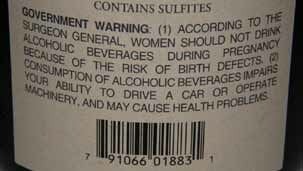 The National Institute on Alcohol Abuse and Alcoholism states that no amount of alcohol is safe during pregnancy and consuming any kind of alcohol can potentially harm an unborn child. The March of Dimes adheres to its position that drinking alcohol during pregnancy can cause harm to the child and no amount of drinking while pregnant is safe. The Centers for Disease Control and Prevention urges pregnant women not to drink alcohol any time during pregnancy. The National Institute for Health and Clinical Excellence (NICE) in the UK advises women who are pregnant to avoid alcohol in the first three months in particular, because of an increased risk of miscarriage. The numerous guidelines are meant to err on the side of absolute safety. A study presented in 2013 at the American Society for Reproductive Medicine in Boston found that women who drank just one or two glasses of wine a week reduced a women’s chances of conceiving by a third. Three or more glasses a week cut the odds of conception by two-thirds. In this small study of 91 women undergoing in vitro fertilization treatment, those who did drank regularly during the week reduced their chances of pregnancy by 70 percent, with binge-drinking reducing the chances even further. Women who abstained had a 90 percent chance of getting pregnant. It is thought that low levels of alcohol can interfere with the normal development of unfertilized eggs, but the mechanism is not clear, and the results of this study could be explained by other factors such as the women who drank were more stressed. Drinking also causes fertility issues in men. As part of National Alcohol Awareness Month in April 2013, screenings were held, and a key finding was that 77 percent of Americans think pregnant women should avoid alcohol altogether, while 20% said an occasional glass of wine is fine. Despite the widespread opposition to drinking any alcohol throughout pregnancy, and the knowledge that the risk of FASD is increased with higher than average alcohol intake during pregnancy, as are juvenile sleep disorders, hyperactivity, attention deficit disorder, and poor coordination and balance in long term studies, there were research studies in 2013 that supported the value of light wine drinking pregnancy. The journal Obstetrics & Gynecology reported a study led by Dr. Fergus McCarthy of the Irish Centre for Fetal and Neonatal Translational Research (INFANT) at Cork University Maternity Hospital in Ireland. The researchers interviewed more than 5,600 pregnant woman in Australia, Great Britain, Ireland and New Zealand about their alcohol consumption before pregnancy and during the first 15 weeks of gestation. The majority of the women consumed alcohol during the first four months of pregnancy (60 percent) with 10 percent drinking a glass of wine or a little less than a 12-ounce bottle of beer once a week, nearly 25 percent consuming three to seven drinks a week, 10% drank moderately (eight to fourteen units a week) and 5 percent drank heavily (more than 14 units a week). More than 33 percent admitted to binge drinking in the three months before become pregnant. When the mothers’ drinking patterns were compared with the health of their babies at birth, the researchers concluded that drinking small amounts both pre-pregnancy and during the first 15 weeks of pregnancy did not seem to increase the risk of premature birth, low birth weight, small for gestational age or high blood pressure in the mother (eclampsia). The study did not look at the long term development of the babies. The authors of the study emphasized that it is unclear whether any safe level of alcohol consumption during pregnancy exists. Research at the School of Social and Community Medicine at the University of Bristol of mothers in the Avon Longitudinal Study of Parents and Children, found that three to seven glasses of wine a week while pregnant does not harm unborn babies and does not impair a child’s neurodevelopment. The study, published in the British Medical Journal, found that babies of mothers who drink wine while pregnant actually performed better in balance testing, a marker for development. The study also found that women who drink wine during pregnancy tend to be wealthier, better educated and older, which could also explain the better balance testing. Almost 7,000 ten-year-old children were assessed. Nearly one in four mothers where either low or moderate consumers of alcohol and nearly one in twenty drank more. Higher alcohol consumption by the father during the first three months of pregnancy was also associated with better performance by children. A widely publicized Danish study from the University of Copenhagen found that women who drank the equivalent of just over one glass of wine a week while pregnant had better emotional and behaved children than those who abstain. The explanation seems to be that the mothers who drank just over one glass of wine a week were the most educated and led the healthiest lifestyles overall. The authors of this study emphasized that it is not an invitation to pregnant women to drink alcohol as the mothers’ healthy lifestyle and education were significant factors in determining the child’s development. The study did not examine the effect on children whose mothers drank heavily. A new book by Harvard-educated economist Emily Oster, Expecting Better, argues against the idea that wine and coffee cause damage to unborn babies and calls it nothing more than a “motherhood myth.” The author looked at hundreds of studies related to drinking wine and coffee during pregnancy (she drank both). About one in eight women in the United States will be diagnosed with breast cancer during her lifetime, and one in thirty-six will die of the disease. A report published in the Journal of the American Medical Association, indicated that advanced (metastatic) cases among those women ages 25-39 have nearly doubled from 1976 to 2009. The trend has not been explained but multiple factors are probably involved including obesity, use of birth control, delayed pregnancy, and high caloric intake. It is still uncommon for young women to be diagnosed with breast cancer (only about 7 percent of all breast cancers diagnosed in the United States). The relationship between breast cancer and alcohol continues to draw considerable commentary in the press. It is generally agreed that the increased risk for drinkers of light-to-moderate amounts of alcohol is quite small. In most observational studies, according to The Forum, the risk of breast cancer is slightly higher in women who average only about one typical drink per day, in comparison with no alcohol consumption. This increase in risk appears to be ameliorated for women who do not binge drink, have adequate folate levels, and do not take hormone replacement therapy. The Forum has the following position: “An individual will need to weigh the modest risks of light-to-moderate alcohol use on breast cancer development against the beneficial effects on cardiovascular disease to make the best personal choice regarding alcohol consumption.” For women with a family history of breast cancer, consumption of wine may protect against BRCA1-associated tumors, while women with BRCA2 mutations may be at greater risk of alcohol-induced breast cancer. Researchers at the Washington University in St. Louis published a study in the Journal of the National Cancer Institute of 91,005 mothers who participated in the Nurses’ Health Study II from 1989 to 2009. All were asked about their alcohol consumption in early life, their alcohol consumption was tracked over 20 years, and they were followed for the development of breast cancer and proliferative benign breast disease (BBD), a precursor of breast cancer. Unfortunately, the researchers did not specifically study wine. The authors of the study found that a woman’s drinking habits between menarche and her first full-term pregnancy were linearly related to a risk of breast cancer. If a female averages a drink per day between her first period and her first full-time pregnancy, she increases her risk of breast cancer by 13 percent and the risk of BBD by 15 percent. The more a woman drinks before her first pregnancy, the higher the risk of breast cancer. The mechanism appears to be related to the rapid proliferation of breast tissue during this period. The researchers recommended that women reduce their alcohol intake to less than one drink a day, and hypothesized that exercise and a high-fiber diet between menarche and the first pregnancy may protect women from breast cancer. Research conduction by the University of Otago in collaboration with the World Health Organization’s Global Burden of Disease 2010 Risk Factors Collaborating Group found that drinking one less glass of wine a night can reduce the risk of women developing breast cancer by 10 percent. Breast cancer was noted to be the leading cause of alcohol-attributable death in New Zealand women. The evidence for breast cancer risk factors among African-American women is limited. A study published in the British Journal of Cancer looked at 803 African-American women with breast cancer in New York and New Jersey. No association was found between light recent drinking and breast cancer risk (African-American women tend to be light drinkers so heavier drinkers were not studied). A borderline decreased risk with increased lifetime consumption was found especially in women who drank when under 20 years of age, but this may have been due to confounding by socioeconomic factors. A study in the Journal of Clinical Oncology from the Cancer Prevention Program at Fred Hutchinson Cancer Research Center in Seattle, showed that modest drinking before and after diagnosis does not affect a woman’s chances of dying of breast cancer. Women who drank moderately (about three to six drinks a week) in the years before their cancer diagnosis, were 15 percent less likely to die from cardiovascular disease than nondrinkers over the 11 years post-diagnosis, on average. Cardiovascular disease is a major cause of death among breast cancer survivors and it is known that alcohol in moderation reduces the risk of cardiovascular disease. Drinking beer or spirits did not have the same benefit and higher levels of alcohol consumption reduced survival chances. This study frees women to make a lifestyle choice, whereas before, they might have been warned not to drink at all if they are diagnosed with breast cancer.
Cancer
A national study reported in the American Journal of Public Health reviewed data from hundreds of thousands of deaths from national medical databases and concluded that alcohol was a cause of 3.5 percent of all cancer deaths in the United States (about 20,000 cancer deaths each year). Breast cancer was the most common cause of alcohol-related deaths in women (about 6,000 deaths annually) and mouth, throat and esophagus cancers were common causes of alcohol-related deaths in men (about 6,000 annual deaths). The risk is highest among those who exceed the recommended dietary guidelines of alcohol consumption, although 30 percent of alcohol related deaths occurred in those who stayed within the guidelines. The study did not examine comparative risks of different alcoholic drinks. Dr. Arthur Klatsky, a well-known alcohol researcher, questioned some of the study’s findings. Dr. Curtis Ellison, a professor of medicine and public health at Boston University School of Medicine, also said the study failed to take into account several factors, such as the pattern of drinking rather than just the amount of alcohol consumed. He pointed out that drinking small, consistent amounts of alcohol is healthier than occasional binge drinking. The study mixed those with alcohol abuse and casual drinkers. The authors of the study acknowledged that alcohol can have health benefits but claimed alcohol causes ten times as many deaths as it prevents and there is no safe level of drinking. The Forum looked at a study published in the International Journal of Cancer titled “Demographic, socioeconomic, disease history, dietary and lifestyle cancer risk factors associated with alcohol consumption.” A cohort of 29,566 adults were studied, but no new information was revealed. The researchers attempted to group all factors into a single, total number for assessing the relation with alcohol intake and this was a weakness of this study. The Forum said, “Some are very weak predictors of cancer, so adding them all up and calling them ‘cancer risk factors’ may not be justified.” The Forum also reviewed a paper published in Annals of Oncology. This PubMed meta-analysis of articles explored the relation of alcohol intake to risk of dying from cancer. The meta-analysis confirmed the health hazards of heavy drinking (equal to or more than 50 g/day) and the benefits of light drinking (equal to or less than 12.5 g/day). The analysis demonstrated a J-shaped curve for alcohol and cancer. Light drinkers showed a statistically significant 9% lower risk, moderate drinkers showed no effect, and heavier drinkers showed a 32% increased of all cancer mortality. Forum members concluded, “The findings from this study do not support the premise that any amount of alcohol increases the overall risk of dying from cancer.” Alcohol consumption and the risk of lymphoid and myeloid neoplasms was the subject of a Netherlands cohort study published in the International Journal of Cancer. Many studies have shown that moderate drinkers are at a lower risk for certain types of lymphoid cancer. This paper did not find a statistically significant reduction in the risk of lymphoid cancers, but a suggestion of an increased risk. The Forum reviewers were concerned about several aspects of this study and did not feel this study should change any current interpretation of the association between alcohol and these types of cancer. The overwhelming scientific evidence indicates that moderate alcohol consumption is associated with a decrease in the risk of many types of lymphoid malignancies while having little effect on myeloid cancers. The Ovarian Cancer Association Consortium studied data using a meta-analysis of nearly 15,000 cases of ovarian cancer in North America and Europe and found no link between ovarian cancer and alcohol. Red wine, but no other form of alcohol, seems to be protective against lung cancer in men. A research team in Spain compared the lifestyles of patients with lung cancer and those requiring minor surgery at the same hospital. Almost 60 percent of the lung cancer patients smoked, compared to 25 percent of the controls. Men in both groups drank similar amounts of wine (around 3.5 glasses per day), but just over one-third of the lung cancer patients drank red wine compared to just over one half of the control patients. Researchers said that each daily glass of red wine afforded 13 percent protection against lung cancer. This was evident even when smoking habits were considered. It is postulated that red wine antioxidant tannins help to block tumor development. Studies of resveratrol and cancer are discussed in the section on polyphenols in wine.
Neurological Diseases and Mental Health
Scientists at the University of Reading in Great Britain published their research in the journal Antioxidants and Redox Signaling showing in a study of lab rats, that a low-to-moderate dose of Champagne for six weeks led to an improvement in spatial memory. Rats who consumed the human equivalent of about a glass-and-a-half a week performed twice as well on maze tests as rats who received no Champagne. Co-author Jeremy Spencer said, “These results illustrate for the first time that the moderate consumption of Champagne has the potential to influence cognitive functioning such as memory.” A comprehensive review of the available research on moderate alcohol consumption and cognitive decline and dementia in old age was published by a group of Italian scientists in the International Journal of Geriatric Psychiatry. The review found that moderate alcohol consumption has more benefit for some types of dementia than others. Light to moderate alcohol consumption seemed to be associated with a decreased risk of overall dementia and Alzheimer’s Disease (AD), but beneficial effects on vascular dementia, cognitive decline and predementia syndromes were less evident. Wine is the form of alcohol most likely to have neuroprotective benefits as long as the AD-associated e4 allele of the APOE gene (ApoE4) is not present. No recommendations were made about levels of beneficial alcohol intake. The authors of the review concluded, “There is at present no indication that light to moderate alcohol drinking would be harmful to cognition and dementia.” A new AD research study published in The Proceedings of the National Academy of Sciences identified a link between the major genetic risk factor for AD known as ApoE4, which is present in two-thirds of the people who develop the disease, and the SirT1 protein that is targeted by resveratrol. ApoE4 causes a dramatic reduction in SirT1 in vitro neural cell lines and in brain samples from patients with ApoE4 and AD. The metabolic benefits of resveratrol may be explained by the increasing of SirT1 which could prevent the abnormalities associated with ApoE4 and AD. The ultimate aim of the research is to find a safe, non-toxic treatment that could be used on anyone who carries the ApoE4 gene to prevent AD. Findings published in the Journal of Biological Chemistry may prove helpful in understanding the cause and progression of AD. In AD, harmful amyloid proteins latch onto brain cells and kill them. Purified extracts of resveratrol from red wine were able to interrupt this process. Added to human and animal brain cells in the lab, the extract of red wine reshaped the amyloid proteins and the amyloid clumping no longer harmed the nerve cells. Indiana University researchers reported the first convincing demonstration in humans that an alcoholic drink’s flavor can releases a chemical in the brain which makes people want to drink more. The study, published in the journal Neuropsychopharmacology, involved scanning the brains of 49 men while they tasted beer and when they tasted Gatorade. Only a small amount of beer was given so as not to inebriate the test subjects. The results revealed significantly more dopamine activity when tasting beer than when tasting Gatorade. Dopamine is a neurotransmitter associated with the reward and pleasure centers in the brain. The subjects also said that after tasting the beer they craved more but did not feel the same way about the sports drink, even though some thought it tasted better. A study published in the American Journal of Clinical Nutrition conducted by French researchers found that there was little benefit to aging brains from a Mediterranean diet. Overall, the study showed that people who ate a diet closest to the Mediterranean diet ideal performed about the same on mental ability testing than those who ate a non-restricted diet. The study did have limitations and did not support previous research that has shown older people who followed a Mediterranean diet were less prone to mental decline as they aged and less at risk for developing Alzheimer’s disease. Research from Sweden examined individuals admitted with an alcohol use disorder or appendicitis from 1972 to 2008 and followed for up to 37 years for a diagnosis of Parkinson’s Disease (PD). Published in BMC Neurology, the study found that a history of alcohol use conferred an increased risk of admission with a diagnosis of PD in both women and men. In particular, the risk seemed higher at lower ages of first admission with PD. Experimental animal studies have indicated that chronic heavy alcohol consumption may have dopamine neurotoxic effects related to PD.
Cardiovascular
The long-term associations between change in alcohol-consumption status and cessation of alcohol use, and
fibrinogen levels in a large, young, biracial cohort was studied within the Coronary Artery Risk Development in
Young Adults Study (CARDIA). Fibrinogen levels, which is a strong determinant of thrombosis and an
important risk factor for coronary heart disease, and alcohol use data were collected at year 7 and year 20
examinations. The results were published in the British Medical Journal. The study found that in comparison
with participants who never drank, those who became or stayed drinkers had smaller increases in fibrinogen,
while those who quit drinking had the highest increase in fibrinogen over 13 years of follow-up. The Forum
considered this a potentially important paper as the finding of higher fibrinogen among never drinkers and
those who quit drinking may relate to the higher risk of coronary disease commonly reported from such
subjects in prospective studies. The Forum concluded, “More research will be needed to determine if changes
in fibrinogen levels are key elements in alcohol’s effects on cardiovascular disease.”
Research published in the Journal of the American College of Cardiology from the University of Illinois found
that four years of heavy drinking between the ages of 18 and 25 in nonsmoking college students could
permanently increase the risk of heart attack and stroke. Students who didn’t drink had more elastic blood
vessels that dilated more easily, compared with the blood vessels of binge drinkers. This could be an early
indicator of blood vessel damage and heart disease, which could increase the risk of future heart problems.
The authors concluded, “Binge drinking may lead to serious cardiovascular consequences in young adults.”
A study from researchers at Harokopio University in Greece reported that a daily pint of beer could be heart
healthy. Published in the Nutrition Journal, the study measured heart health after drinking a pint of beer in 17
healthy non-smoking men compared to the heart health after drinking non-alcoholic beer and vodka. The
researchers found that blood vessel endothelial function was significantly improved only after beer
consumption. The benefit seems to be mediated by the effects of alcohol and antioxidants. Beer has also
recently been found to reduce the chance of developing kidney stones and can help control cold-like viruses.
Researchers from the Universities of Barcelona and Valencia compared the effects of red wine, gin and
alcohol-free red wine on the cholesterol and blood sugar of 67 men at high risk of cardiovascular disease in a
randomized clinical trial. The men drank about one glass of wine or two large gins and tonics each day for four
weeks at a time. The subjects ability to metabolize sugar improved after both types of wine, but not with the
gin. Their levels of lipoprotein-a, a compound that are associated with a greater risk of heart attack, decreased
with red wine only. The research team suggested that the non-alcoholic fraction of red wine, mainly
polyphenols, were responsible as both alcoholic and non-alcoholic wines were nearly equal in their benefit.
The study was published in Clinical Nutrition.
A study of 11, 248 Italian men and women who had recently survived a heart attack, published in the
International Journal of Cardiology, looked at how wine affects mortality in those who have serious cardiac
disease. This research showed that patients who have a heart attack are less likely to have another one and
have a greater chance of living longer, if they drink wine in moderation compared to non-drinkers. Men and
women who drink two large glasses of either red or white wine a day have a 13 percent less likely chance of
suffering another heart attack and reduce their chances of dying from heart disease by about 17 percent
compared to non-drinkers. The study results only apply to people who were already drinking wine on a regular
basis when they started the study.
A meta-analysis of sixteen studies published in the Journal of Clinical Hypertension revealed that light drinking
can reduce the risk of high blood pressure. Women who drank a glass of wine or less per day decreased the
risk of high blood pressure by up to 13 percent. Men who drank one to two glasses per day did not show as
large a benefit but did not have a higher risk of high blood pressure. Heavy drinkers showed a higher risk of
high blood pressure which potentially can lead to cardiovascular disease and stroke.
Diabetes
Type 2 diabetes and chronic kidney disease are important public health problems. An observational study
published in JAMA Internal Medicine reported that eating a healthy diet and drinking a moderate amount of
alcohol may be associated with a decreased incidence and risk of progression of chronic kidney disease in
patients with type 2 diabetes mellitus.
Weight & Metabolism.
An article in The New Zealand Herald refutes the promise that low-alcohol, low-calorie wines are healthier
because many of them are not considerably lighter and may lead people to drink more. Treasurer Wine
Estates and Australia’s Accolade Wines are promoting “light” wine products for Weight Watchers in the United
States. These wines have about 25 percent less alcohol but drinkers may compensate for the diminished
calories by eating more food. The author of the article, Julie McIntyre urged the government of Australia to
initiate consumption guidelines on “light” wines.
A study published in the Annals of Nutrition and Metabolism conducted by researchers at French universities
found that daily, moderate consumption of alcohol may keep men thinner. Nearly 8,000 men between the ages
of 50 and 59 were followed. Those who drank occasionally (one to two days a week) were more likely to be
obese followed by frequent drinkers (three to five days a week). The subjects who drank daily (an average of
15 glasses of wine per week) were most likely to be trim.
Miscellaneous Studies on Various Body Organs
A Polish study published in Systems Biology in Reproductive Medicine reported that men who drink wine up to
three times a week create stronger sperm. Stronger sperm are better swimmers which increases the chance
of fertilization. Increased leisure time, light coffee drinking and the wearing of boxer shorts also improved
reproductive strength, while the regular use of a mobile phone for more than a decade decreased sperm
mobility.
Dental school researchers in Australia and India published a study in Oral Health and Dental Management in
which they collected saliva samples from subjects both before and after alcohol consumption and analyzed the
samples for levels of acidity, ionic calcium and inorganic phosphate. Increased saliva acidity can damage
enamel, and when tooth enamel dissolves, calcium and phosphate ions are released. The study found that a
single drinking occasion can measurably affect tooth enamel. A significant reduction in mean salivary pH after
consumption of any form of alcohol was observed with the highest reduction caused by beer, followed by
whiskey and wine, yet beer showed the lowest increases in calcium and phosphate. The study has implications
for wine tasters because pH levels remain significantly decreased for several minutes after a wine taster spits.
Wine tasters who swirl and swish before spitting are at greater risk for dental enamel damage. The lead author
of the study recommended following wine tasting with a swig of water or milk both of which have a neutral pH.
He also suggested that wine tasters not brush their teeth immediately after tasting since the enamel is already
softened. The best option is to brush after one hour with a toothpaste that is low in abrasive quality and
contains remineralizing agents. It is believed that this enamel erosive effect is unimportant for drinkers in the
general population who are exposed to more risk from the widespread ingestion of carbonated soft drinks.
Apparently red wine stains teeth more than coffee following teeth whitening treatments according to a study
published in Acta Odontologica Scandinavica. A team of researchers in Brazil studied the effect of coffee and
red wine staining on tooth color before and after bleaching. After whitening procedures, both coffee and red
wine caused enamel color changes, but the wine led to greater staining than did coffee.
Using data from three large ongoing surveys, the Health Professionals Follow-Up Study (HPFS), and the
Nurses’ Health Studies I and II (NHS 1 and NHS II), that included 194,095 participants, the rate of kidney
stones in subjects who drank certain beverages was recorded. The study found that consumption of sugar-sweetened
soda was linked to a 23 percent increased risk of kidney stones while coffee (26 percent lower risk),
tea (11 percent lower risk), orange juice (12 percent lower risk), wine (31 to 33 percent lower risk), and beer (41
percent lower risk) were linked to lower risk for kidney stones. The cause of the increased risk of sugary drinks
and the lowered risk of certain other drinks such as wine is unclear. Participants who drank at least one
serving of wine every day showed a significantly lower risk of kidney stone formation than occasional drinkers.
The study was published in the Clinical Journal of the American Society of Nephrology.
A paper presented at the American Society for Bone and Mineral Research in 2013 reported that grape
consumption may help protect bone health. The research used an animal model for menopause to investigate
the long-term benefits of grape consumption on bone health. Animals who consumed a grape-enriched diet
had improved bone calcium retention compared to a control diet without grapes.
Two studies, one published in the Journal of Functional Foods, and one in the Journal of Cardiovascular
Pharmacology, found that drinking red wine with meals is beneficial to one’s health. In the first article, a study
from Israel found that free radical molecules associated with oxidative stress were reduced significantly when
turkey cutlets were ingested with red wine. In the second article from Germany, subjects who drank red wine
while eating French fries and pork sausage had lower levels of inflammation in their blood vessels than those
who drank other beverages. Blood vessel inflammation was markedly increased when Coca-Cola was drank
with the meal.
A study of Grave’s disease (hyperthyroidism) in Denmark published in Clinical Endocrinology, found that
abstainers were more likely to develop Grave’s disease than those who drank alcohol regularly. Subjects who
drank in moderation, defined as 1 to 2 glasses per day, had much less Grave’s disease than those who drank
lightly, defined as 1 to 2 glasses per week. The type of alcohol consumed made no difference. This study
adds Grave’s disease to the list of other autoimmune diseases such as systemic lupus erythematosus,
rheumatoid arthritis, and autoimmune diabetes that appear to be less common in moderate consumers of
alcohol.
A meta-analysis search of MEDLINE was done to study the association between alcohol consumption and the
risk of rheumatoid arthritis and published in the Annals of Rheumatology. Low to moderate wine consumption
was found to be inversely associated with the development of rheumatoid arthritis. A J-shaped curve was
suggested with a lowered risk on average intake of about 1 to 1.5 standard drinks in comparison with nondrinkers
and an increased risk for heavier drinking. The effects seemed to be significant for both sexes.
According to The Forum, the beneficial effects of alcohol on autoimmune diseases is likely due to down
regulation of the immune response and a decrease in pro-inflammatory cytokines.
In the Women’s Health Initiative Observational Study, the relationship between alcohol consumption and
preference for alcohol type with the risk of melanoma and non-melanoma skin cancer was examined and
published in Cancer Causes Control. The study’s conclusion was that higher current alcohol consumption,
higher lifetime alcohol consumption, and a preference for white wine or liquor were associated with an
increased risk of melanoma and risk of non-melanoma skin cancer. It would seem from other researcher’s
comments that the association with alcohol is statistically solid, but not the beverage type data. The Forum
notes that much of the association may relate to residual confounding by ultraviolet sun exposure which is the
most important environmental factor for these skin diseases.
A study on primates published in Vaccine from immunologists at the University of California, Riverside,
gathered data to show that moderate alcohol consumption could strengthen our immune system, and
potentially our ability to fight infections. The rhesus monkeys who drank heavily showed a diminished response
to the vaccine. The moderate drinkers had an enhanced immune response in comparison to the control group.
This is the first study to show that moderate alcohol consumption has a specific beneficial effect on immune
responses to vaccination.
Summary
Klatsky has also said the following regarding causality. “Heavy drinking increases the risk of developing certain
cancers, such of those of the mouth, liver, breast, colon and rectum. Light or moderate drinking slightly
increases the risk of breast cancer, but its effect on other forms of cancer is not clear cut. For men and women
over the age of 50, the benefits of moderate amounts of alcohol generally outweigh the risks, but advice about
drinking needs to be individualized. An older man at risk for cardiovascular disease, for example, would benefit
from moderate drinking.”
That is not to say that people over 50 years of age should start drinking because of perceived health benefits of
alcohol, but rather they should consult their doctor. Dr. Ethan Schram, an oncologist, has said, “I personally tell
my patients that they can do most anything in moderation - except smoking.”
Wine as Part of a Healthy Lifestyle: Update on Resveratrol & Other Polyphenols
John LaMattina, former president of Pfizer Global Research Conferences
As the Resveratrol Conference information stresses, the claims of the health-promoting effects of resveratrol are mostly based on animal and in vitro studies while human studies are lacking. Taking all the research to date into account, studies on the potential health and life-extending benefits of resveratrol are inconclusive. In spite of that, many public and scientific medias contain statements that resveratrol may prevent life-style diseases like cancer, cardiovascular disease, diabetes and Alzheimer’s disease as well as prolonging life. There are many resveratrol derivatives, but they have been much less researched. A high level of resveratrol derivatives have been found in Melinjo (Gnetum Gnemon) and other Gnetum species and the meeting in Tokyo directed special focus to resveratrol derivatives. Melinjo has been studied for more than ten years, mainly by Japanese scientists. Data presented during the meeting indicated that a surprisingly low dietary dose of resveratrol has efficacy in cancer chemoprevention. Other studies from Japan supported resveratrol use as a potential immunotherapuetic agent and that melinjo/GnetinC could be more useful than trans-resveratrol for prevention of cancer and other angiogenesis-related diseases. The chemical representation of trans-resveratrol:
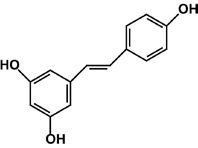
Associate Professor Cedric Saucier, who runs the enology lab at University of British Columbia’s Okanagan campus, discovered 23 new molecules related to resveratrol in extracts of Merlot, Pinot Noir and Cabernet Sauvignon. These new molecules, which still need to be analyzed and assessed, may contribute to the benefits of drinking red wine. A Danish study published in the Journal of Physiology was controversial in claiming that resveratrol found in red wine lessen the benefits of Crossfit exercise since resveratrol has been shown to mimic the effects of exercise training. The study of healthy men about 65 years old found that exercise improved their cardiovascular health but the effect was 50 percent less in the group receiving resveratrol compared to the group receiving a placebo. The reasons for this are unclear. The amount of resveratrol given to the subjects was about 100 times that found in one glass of Pinot Noir so athletes who drink wine should not be concerned that a glass or two of wine will negate all the effects of their exercise. Research published in the Journal Otolayrngology-Head and Neck Surgery found that giving rats reservatrol (Delta Labs Extra Strength Red Wine Extract) reduced the amount of hearing and cognitive decline due to noise-induced damage. Resveratrol significantly decreased levels of COX-2 which is increased by loud noise and linked to inflammation and hearing loss. Further studies are needed to see if the results can be duplicated in humans. A study published in the Journal of Nutritional Biochemistry found that grapes can improve the heart health of hypertensive rats with heart disease in as little as 18 weeks. In the rats who received a grape-enriched diet, the animals suffered a lower rate of heart failure and a lower levels of high blood pressure. It was postulated that grape polyphenols cause heart cells to produce glutathione, an important antioxidant in the heart. The study authors recommended eating whole grapes for the maximum health benefits. In the International Journal of Cancer, epidemiological researchers in Germany analyzed whether doses of resveratrol found in wine could negate the carcinogenic properties of alcohol. The results indicated that a person would need to drink 100 glasses of wine per day to reach effective dosages of resveratrol. The research team had previously published a study that linked alcohol consumption to cancer and this follow-up study found that the original study findings are not confounded by the possible anti-carcinogenic properties of resveratrol. A study published in Food and Chemical Toxicology found that de-alcoholized wine with a high concentration of the polyphenol, gallic acid, stopped aggressive bone cancer in the lab. A clinical trial showed that glucose metabolism is improved more by red wine than by gin. Published in Clinical Nutrition, this study of subjects at high risk of cardiovascular disease compared the effects of moderate consumption of red wine, dealcoholized red wine, and gin on glucose metabolism and the lipid profile. The results support a beneficial effect of the non-alcoholic fraction of red wine (mainly polyphenols) on insulin resistance, conferring greater protective effects on cardiovascular disease to red wine than other alcoholic beverages. There was some effect from alcohol, but polyphenols were even more important in improving glucose metabolism. Forum reviewer Dr. Arthur Klatsky said, “It joins the substantial number of reports presenting data suggesting that drinkers of red wine have more favorable levels of various markers of potential risk of atherothrombotic disease, compared with drinkers of other alcoholic beverages. However, without clinical endpoints, these reports indicate only hypothetical or potential benefit for disease. A study published in the Journal of Surgical Research found that resveratrol in red wine and grape skins inhibited the survival of melanoma cells undergoing radiation treatment. Simply treating cancer cells with resveratrol killed 44% of tumor cells. When resveratrol was combined with radiation treatment, 65% of tumor cells died. The researchers now plan to explore how to deliver resveratrol to tumor sites to treat cancers. The dose used in this study was extracted and far higher than levels naturally found in a glass of wine or grapes. Earlier work by the researchers found that resveratrol made prostate tumors more susceptible to radiation treatment. A study appearing in Nutrition and Cancer found that a procyanidin polyphenol (B2G2) isolated from grape skins and seeds and in a synthesized form inhibited cell growth and induced apoptosis (cell death) in human prostate cancer cells. The results confirmed previous studies in mice. A team of researchers in Korea published a study in Food and Chemical Toxicology that supports the cancer fighting power of resveratrol. This was the first study to look specifically at mesothelioma, a rare, aggressive cancer related to asbestos. Resveratrol in combination with clofarabine synergistically had a strong cytotoxic effect on mesothelioma cells. Research published in The Journal of Nutrition measured total polyphenol urinary concentrations over a 12- year follow-up study in 897 men and women aged 65 and over within the INCHIANTI study to assess the effect of polyphenol-rich diets on longevity and risk of mortality. This was the first time such a biomarker was used for an epidemiological study. The researchers found that overall mortality was reduced by 30% in subjects who had rich polyphenol diets in comparison with those who had low polyphenol diets. The conclusion was, “The results corroborate scientific evidence suggesting that people consuming diets rich in fruits and vegetables are at lower risk of several chronic diseases and overall mortality.” According to Wines & Vines (January 2014), University of British Columbia at Okanagan researchers have developed a new method for analyzing polyphenolic content in wine. Named “shotgun polyphenomics,” the test would give a unique “wine fingerprint” for each wine studied.
Supplements.
A study published in Diabetes from Denmark looked at a group of 24 obese but otherwise healthy men who were given 1,500 milligrams of resveratrol or a placebo daily. The resveratrol had no effect on the men, calling into question the value of resveratrol supplements. Another study published in Cell Metabolism involved 29 post-menopausal women without type 2 diabetes who were reasonably healthy. For 12 weeks, half took an over-the-counter resveratrol supplement (75 milligrams daily, the same amount they would get from drinking 8 liters of red wine), and the rest received a sugar pill placebo. Researchers found that resveratrol supplementation did not offer any metabolic benefits. The authors of the study noted, “This does not preclude the possibility that resveratrol could have a synergistic effect when combined with other compounds in red wine.” Research published in Neurology found that older adults who eat diets high in antioxidants may not have a lower risk of dementia or stroke. The Netherlands study of 5,395 people aged 55 years and older who ate or drank lots of coffee, tea, oranges, and red wine were just as likely to develop neurological problems over the 14 years of follow-up as those who skimped on antioxidant-rich foods. Since the study only looked at foods, it could not address whether antioxidant supplements have an impact on dementia or stroke risk. A study from Louisiana State University found that resveratrol can worsen multiple sclerosis symptoms in mice when taken as a supplement. The results were published in the American Journal of Pathology. The researchers were surprised as resveratrol has been associated with neuroprotective effects. The study authors discourage supplement use in patients with multiple sclerosis. A meta-analysis of 19 reservatrol studies across six species was published in Biology Letters. Researchers found that while resveratrol contributed to increased life span in lower-level species such as yeast and nematodes, there was no consistent evidence of the same effect in higher-order species including fruit flies and mice which are the closest species to humans studied to date. The researchers only looked at anti-aging effects. They concluded, “It is inappropriate for resveratrol to be marketed as a life-extending health supplement.” One of the arguments against resveratrol supplements is that they do not contain alcohol and it is the combination of alcohol and multiple polyphenols such as resveratrol working synergistically in combination that appears to provide the health benefits of red wine. Also, resveratrol supplements contain a far lower dosage than research has shown to be of benefit and resveratrol is absorbed 250 times more effectively when consumed in wine as opposed to a supplement form. Although there is no scientific evidence that resveratrol supplements in humans have health benefits, the supplement business, which is not regulated by the FDA, is now a $30-million-a-year giant. Unfortunately, resveratrol supplements are probably a waste of money.
Polyphenol-Enhanced Wines
 Kathleen Corsbie and Annie Winmill of Southern Wine New Zealand have introduced a range of wines named Balancing Act Wines that contain 40 times more resveratrol. The Balancing Act wines use the patented technology developed by Dr. Norrie that increases a wine’s resveratrol content without affecting color, aroma or taste. One glass of Balancing Act wine is equivalent to consuming the resveratrol contained in about 40 glasses of regular wine. The producers make no health claims. An Australian biochemist, Greg Jardine, has patented a group of compounds that are created during the winemaking process which have anti-inflammatory effects and may have benefit in treating arthritis and chronic fatigue. His process, called Modified Polyphenol Technology (patent pending), involves steps in winemaking that intensify certain processes and result in increased levels of fat-soluble tannins that are better absorbed than the common antioxidants in wine without making the wine less palatable. Preliminary study has shown that Jardine’s compounds improve the health of rats with arthritis. The wine is sold under the name, “Dr. Purple.” The dry style version of the wine is a combination of Shiraz and purple carrot. Visit www.drred.au.com. There is a trend that began last year of “healthy” alcoholic drinks that include wines infused with goji berries and ginseng, as well as lower calorie options according to the supporters of the Healthy Beverage Expo held in Las Vegas. Pinot Noir containing mulberry juice and omega-3s anyone?
Snippets of Health Related Wine News in 2013-- Mayo Clinic physicians recommend raising “sin” taxes on alcoholic beverages as well as tobacco, sugary drinks and fatty foods. The article was published in the journal Mayo Clinic Proceedings. In Australia, as well, there are advocates of taxing wine by alcohol content, claiming that it would reduce alcohol consumption and save millions in health care costs. The wine equalization tax would replace the current tax that is based on value. -- The French Senate considered a bill that would impose new restrictions on wine, implying that wine is a public health threat. Sin taxes on wine would increase and labels would be required to carry the warning, “Alcohol is dangerous for your health.” New restrictions on advertising and marketing were also proposed. -- Health groups in the United Kingdom are demanding the elimination of all alcohol advertising. The impetus for this was a study by the University of London that found that 44 percent of men and 31 percent of women drank more than the recommended government guidelines. A higher unit price for alcohol was also proposed. -- Alcohol Policy 16 conference in Arlington, Virginia, called for taxes and regulations that limit access to alcohol. This group seems to feel that no level of drinking is responsible. I agree with Angela Logomasini, commenting at www.openmarket.org about the conference, “Speakers largely dismissed the idea that health policy related to alcohol should focus on promoting individual responsibility. They forget, we are supposed to live in a free society - one that abolished alcohol prohibition, which proved to be a miserable failure. Ultimately individuals need to be responsible.” -- There is a a new voice for wine consumers called The American Wine Coalition (AWCC) founded by wine consumers. The AWCC will lobby at the state and federal level for the rights of wine consumers, inform the media of the interests of wine consumers, educate members and non members on the politics behind wine, and support other organizations willing to advance the rights of wine consumers. I suggest you join the AWCC ($35 per year), raise your voice, and publicly endorse the AWCC. Visit www.wineconsumers.org. -- Federal safety regulators (NTSB) in May 2013 urged states to lower the legal limit for drivers’ blood-alcohol content from 0.08% to 0.05%. The response of the Wine Institute was sensible: “Lowering the legal threshold would effectively criminalize moderate social drinking by responsible adults and divert resources that should be used to target drunk drivers. AAA reported in late 2013 that a first-offense misdemeanor DUI conviction for an adult 21 or older in California was $15,649. -- MIT scientists have developed a mixture of alcohol metabolizing enzymes that quickly reduces blood alcohol levels in inebriated mice. The treatment could have many implications for alcohol drinkers. Drunken mice that received the enzyme injection sobered up quicker than those that did not receive the enzyme treatment. The treatment has not been tested on humans but the study’s researchers envision a pill that could be taken as an antidote to alcohol, helping to digest alcohol before it reaches the circulation. -- An irresponsible article appeared at www.dailybeast.com by Jordan Salcito that claimed “natural wine” does not lead to hangovers. This absurd proclamation is unfounded because hangovers are due to ethyl alcohol and all “natural wines” contain relatively the same percentage of ethyl alcohol. -- According to Gallup’s annual Consumption Habits poll, Americans now prefer wine just as much as they prefer beer. In the poll, 36 percent preferred beer, and 35 percent favored wine. The preference for wine rose from 14 percent in 1992 to 24 percent in 2013 in the under 30-year-old age group, and 37 percent to 46 percent in the same period for people aged 50 and above. -- A Danish supermarket study found that wine drinkers are generally more healthy eaters compared to beer drinkers. Wine drinkers bought more olives, fruit, vegetables, low fat cheese, milk, poultry and cooking oil, while beer drinkers bought more cold cuts, chips, pork, butter, sausages, lamb and soft drinks. The study suggests that the health benefits of moderate wine consumption may but partially due to diet rather than the wine itself.
Pinot Briefs12th Annual Pinot Noir Summit Produced by Chief Wine Evangelist, Barbara Drady, this event will be held March 9 at The Presidio in San Francisco. Early Bird discounted tickets are now on sale at www.affairsofthevine.com. The event will feature a Sparkling Wine Brunch, VIP Pinot Noir Workshops, the Pinot Noir Blind Tasting of the best wines from the Pinot Noir Shootout, and a Grand Awards Tasting & Ceremony with the winemakers. I am stepping out from under my writing cap to participate as Competition Director and would love to meet any of PinotFile readers at this special Pinot Noir sensory experience. I am gathering some special magnums of Pinot Noir to share. World of Pinot Noir This grand event, February 28-March 1, 2014, will be held this year in Santa Barbara at the plush Bacara Resort & Spa. Get off your couch and head to Santa Barbara for a weekend of immersion in the special world of Pinot Noir. Many top wineries are participating including Alma Rosa, Alta Maria, Ampelos, Anaba, Baxter, Belle Glos, Black Kite, Brewer-Clifton, Calera, Cirq Estate, Couloir, Domaine Serene, Dunstan, EnRoute, Failla, Fiddlehead, Flowers, Flying Goat Cellars, Foxen, Freeman, Gary Farrell, Hirsch Vineyards, Keller Estate, Ken Brown Wines, Kosta Browne, La Crema, Laetitia, Littorai, MacPhail, Maison Louis Jadot, Martinelli, Merry Edwards, Papapietro Perry, Patz & Hall, Paul Lato, Peay, Penner-Ash, Pisoni, Roar, Robert Talbott, Sea Smoke, Siduri, Seagrape Wine Co., Sinor-LaVallee, Soter, Talisman, Talley, Thomas Fogarty, Thomas George, Trisaetum, Twomey, Williams Selyem and many, many more! Get tickets now at www.worldofpinotnoir.com. Chehalem Mountains Winegrowers Trading Cards The Chehalem Mountains Winegrowers (CMW) have issued trading cards introducing the unique characters who make this wine growing region special. The CMW, which includes Ribbon Ridge, has rolled out the first collection of limited-edition trading cards featuring 28 characters including respected industry pioneers and many of the well-known winemakers in Oregon. Card collectors will find winery statistics and interesting information on soils, acreage, grapes and more, and discover little-known facts about the people behind the wines. Surprisingly, there is a former rock band manager, a winemaker who plays with insects, and one who rides dressage. Each winery will hand out limited edition trading cards on request. Patrons who collect all cards will receive complimentary wine tastings for two at participating wineries, and be entered in a drawing to win tickets to the CMW annual consumer event and other prizes. The Chehalem Mountains AVA, established in 2002, is home to approximately 150 vineyards over 1,400 acres, and over 50 established wineries and producers. Chehalem (pronounced “Sha-HAY-lum) is derived from a Calapooia Indian word best translated as “gentle land.” The card below shows Paul Gates of Gresser Vineyard. Visit www.chehalemwinegrowers.org for more information.
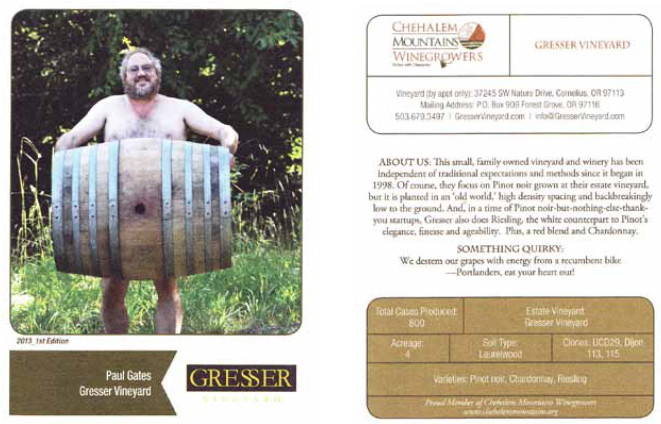 $80 New Norm for PINO (Price Is No Object) In the past few weeks I have been receiving new offerings for the 2012 vintage Pinot Noirs from many of my favorite producers and I have noticed that $80 seems to be the norm or sweet spot for many quality wines, with prices often ranging from $70 to $100 a bottle. An $80 bottle of Pinot Noir with California tax and shipping pushes the cost over $90 a bottle. Wineries feel flush now that direct to consumer (DtC) wine shipments are at a record high and apparently quite comfortable with charging $80 a bottle. The Annual Wine Shipping Report from Ship Compliant and Wines & Vines shows DtC wine shipments growing at a rate far exceeding the overall growth of the American wine retail sector. DtC shipments grew to $1.57 billion dollars in 2013, an increase of 7.7% from 2012 and the volume of shipments increased 9.3% to 3.47 million cases. Average price per bottle was $37.78. Pinot Noir grew in average bottle price in DtC shipments to $41.97 (an increase of 0.9% over the prior year), while red blends, Merlot and Chardonnay decreased in price. Shipments of Pinot Noir continue to increase across the country. Both Sonoma County and Oregon, both hotspots for Pinot Noir production, experienced explosive growth in direct shipments in 2013. Jimi Brooks’ Legacy Continues. Less than two years ago, Jamie Brooks Hueck was approached by a film company called Three Crows Media. They were filming a movie called “American Wine Story” about why people leave their day jobs to risk following their dreams by entering the wine industry. As they were interviewing many winemakers and growers, they kept hearing about the story of Jimi Brooks. After meeting with them, Janie agreed to participate. Since then, Pascal, Chris, Janie’s spouse, David, and Janie have been interviewed many times. Last November, Janie went to a screening of a rough cut of the movie in Salem. The history of Janie’s brother, Jimi, and how he found his way into the wine industry and founded Brooks Winery is featured prominently in the movie. It is an amazing tribute to Jimi Brooks and his legacy ten years after his passing. Rough cuts of the movie are being submitted to various Film Festivals. Brooks is looking to host screenings of the movie throughout the country once it is finished and at some point should be available on DVD. Check it out at www.thewinemovie.com.
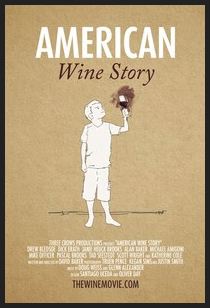 Large Wineries Turning to Robotic Optical Grape Sorting Table Grapes have always been sorted by hand in the North American wine industry. Now high flow rate sorting tables are available that can do the work of many people. Their high cost precludes their use in all but the largest wineries. The winemaker enters a composite “ideal grape” profile generated from images of “perfect” grapes. When loose grapes are fed into the sorter, a high-seed camera captures 10,000 images per second which are analyzed and compared to the ideal. If the grape doesn’t match up, it is sent into the reject pile by a puff of air. Kelli White wrote an article in The World of Fine Wine (“Unnatural Selection? Extreme Sorting in the Napa Valley” Issue 43, 2013). She, along with a number of winemakers interviewed for the article, feel that the extreme optical sorting process strips wine of its potential complexity. She wonders, “Top-end producers in Napa might be going to far, sacrificing individuality, complexity and balance for concentration, softness, and purity of fruit.” Napa vintner Randy Dunn, a critic of optical sorting who sorts his grapes in the vineyard, says, “We do not sort our grapes at the crusher - that is for the new wave of geek winemakers that want to make that slippery stuff.” New Edition of Wine Science by Jamie Goode Jamie Goode, who writes an award-winning blog at www.wineanorak.com, will release an updated version of Wine Science: The Application of Science in Winemaking, which is published in the United States as The Science of Wine: From Vine to Glass. It will be available from www.amazon.co.uk February 3, and from www.amazon.com at the beginning of April. It has been nine years since Goode wrote the first edition, so he has added new chapters, revised the entire book, and contributed a considerable amount of newly discovered knowledge. Highly recommended.
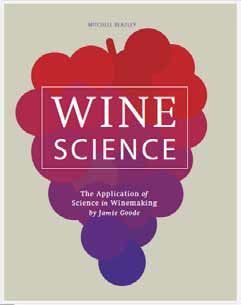 Jamie Goode Also Releases New Zealand Pinot Noir An extended report, or e-book, on New Zealand Pinot Noir discusses style, vine age, clones, a brief history, and a focus on 85 producers and 255 wines. The 115-page e-book is available. Available on Amazon Kindle.
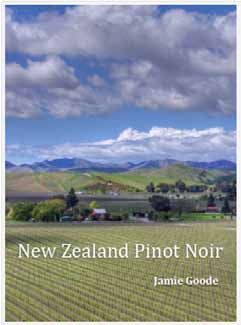 Yamhill-Carlton Features Branded Bottles According to Wines & Vines, the Yamhill-Carlton AVA has initiated a program in which Pinot Noir bottles are embossed with the name of the appellation and logo of the Yamhill-Carlton Winegrowers Association. Branded bottles are used in parts of Europe such as the Rhone and Piedmont, but are uncommon in North America. Several wineries will feature the new bottles including Ken Wright Cellars, Asilda Winery, Ghost Hill Cellars, Lazy River Vineyard, Roots Wine Co., Stag Hollow and WildAire Cellars. Arista Winery Garden & Chef Update Arista Winery in the Russian River Valley has announced that Executive Chef and gardener, Tim Kaulfers, is harvesting from Arista’s estate gardens year-around, and is planning seasonal menus around the winery’s garden bounty. Chef Tim’s goal is to use almost exclusively the winery’s gardens to provide the seasonal ingredients. Reservations can be made to taste how estate-grown produce and local meats are crafted into fine-dining dishes paired with Arista wines. The Arista Food & Wine Experience is offered Tuesday through Saturday at either 11:00 AM or 2:00 PM by advanced resvervation for $95 per person. Contact Arista’s Director of Hospitality, Leslie Farvel, at lesliefarvel@aristawinery.com, or call 707-473-0606. Arista Winery is an outstanding producer of premium Pinot Noir, located on Westside Road in Healdsburg. Eight Street Wineries Open House On February 22, 2014, from 12pm-4pm, the nine members of the Eighth Street Wineries of Sonoma will have a open house. Wineries include Pinot Noir producers Parmelee-Hill Wines, Talisman Wines, MacRostie Winery, Three Sticks, Anaba Wines, Enkidu Wines and Tin Barn Vineyards. Visit www.eighthstreetwineries.com/events/ for information and tickets ($40). Yeast Identified that Produces Lower Level of Alcohol The Australians released their research before publication in the journal Applied and Environmental Microbiology. The escalation of alcohol percentage in wines over the last 15 years, the concern about health issues, and taxes (some countries tax wine based on alcohol content), have been the impetus to develop wines with lower alcohol content. 50 different isolates were studied and the most successful yeast was a non-Saccharomyces yeast, Metschnikowia pulcherrima AWRi1149. Once the slower-growing yeast had consumed 50 percent of the sugar, S. cerevisiae was added to finish the process. This sequential inoculation reduced alcohol content in Shiraz from 15.0% to 13.4%, and somewhat less in Chardonnay. 50th Anniversary of Hearty Burgundy My father’s favorite wine was Gallo Family Vineyards Hearty Burgundy so it is a vivid part of my past. Hearty Burgundy was first introduced 50 years ago by pioneering American winemakers Ernest and Julio Gallo and was the favorite wine of the brothers. The red blend has often been praised as the best wine value in California. To commemorate the 50th anniversary, Gallo Family Vineyards has produced a limited edition bottle that pays homage to the original flavor profile that first brought Americans into wine in the 1960s and 1970s. The exact varietal mix has varied from vintage to vintage, but Zinfandel and Petite Sirah have always been a part of this wine, making “Burgundy” a glaring misnomer. In the early 1970s, Hearty Burgundy did contain Pinot Noir from now iconic producer Rochioli. The limited edition bottling will go on sale in February 2014 for a suggested retail price of $9 for a 1.5 liter bottle. China Top Consumer of Red Wine According to www.thedrinksbusiness.com, China has become the largest red wine market in the world, consuming 155 million 9 liter cases in 2013. Chinese red wine consumption has rocketed by 136% since 2008. France is now in second place and Italy in third place. The IWSR survey found several reasons for this appetite for red wine including the perception that wine is healthy and the association of red with wealth, power and good luck in Chinese culture. China is the fifth largest producer of wine in the world and supplies 80% of the wine consumed in that country. Imports, however, multiplied seven times between 2007 and 2013 and now represent 18.8% of all wine consumed in China. Riedel Glass for Coca-Cola According to Blake Gray posted in www.wine-searcher.com, Riedel has produced Coca-Cola + Riedel glasses which sell for $19.99 each. The top of the stemless glass is the shape of Riedel’s O-series Sauvignon Blanc glass, and the thin waist opens to a small bottom section, giving the glass a look of the Coke classic 6!-ounce glass bottle. The glass is not recommended for Diet Coke, Pepsi- Cola or other colas. As a side note, Riedel is also developing a range of glasses for tea.
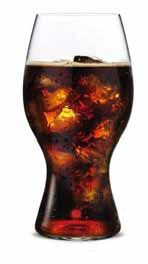 |
